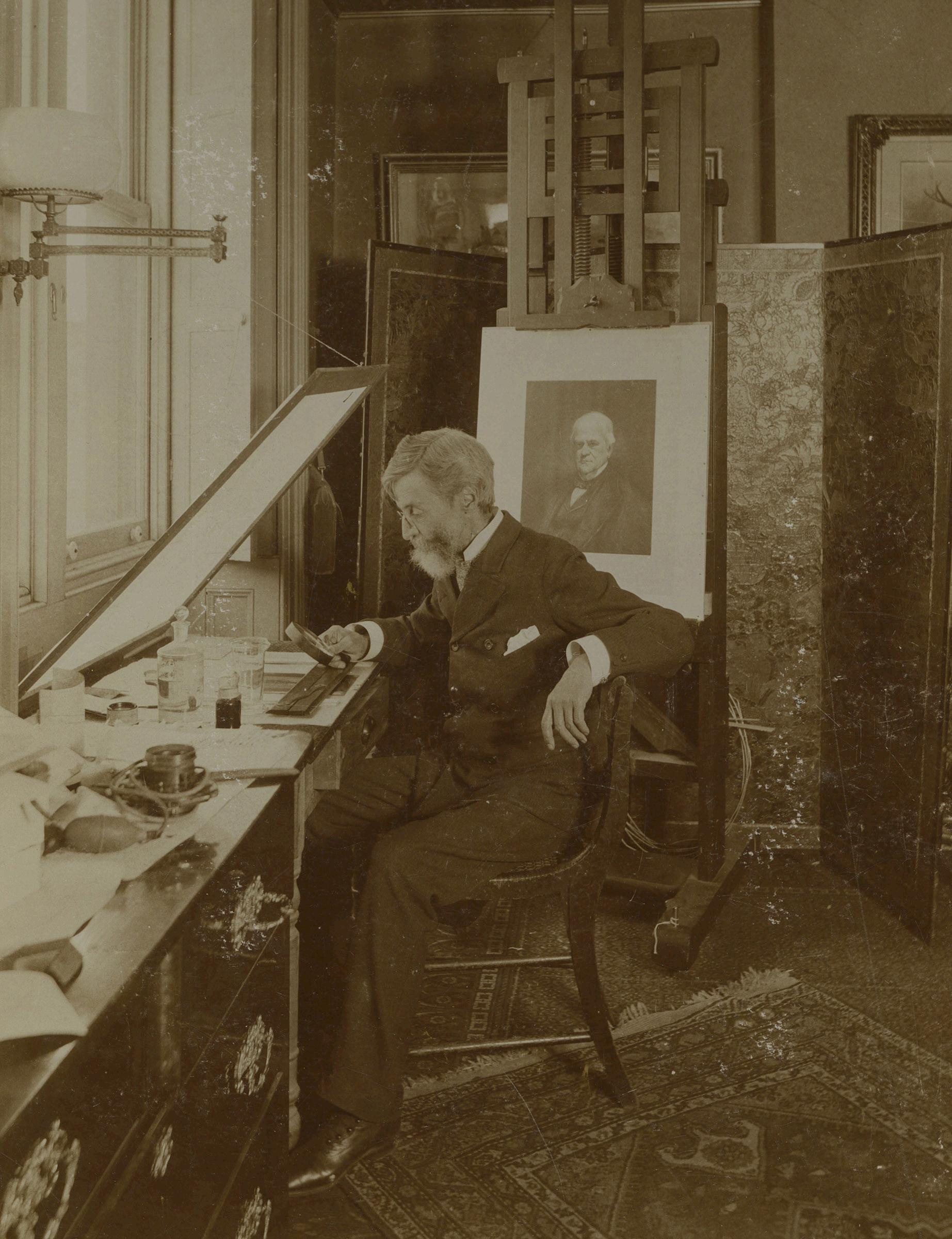
1833 - 1909
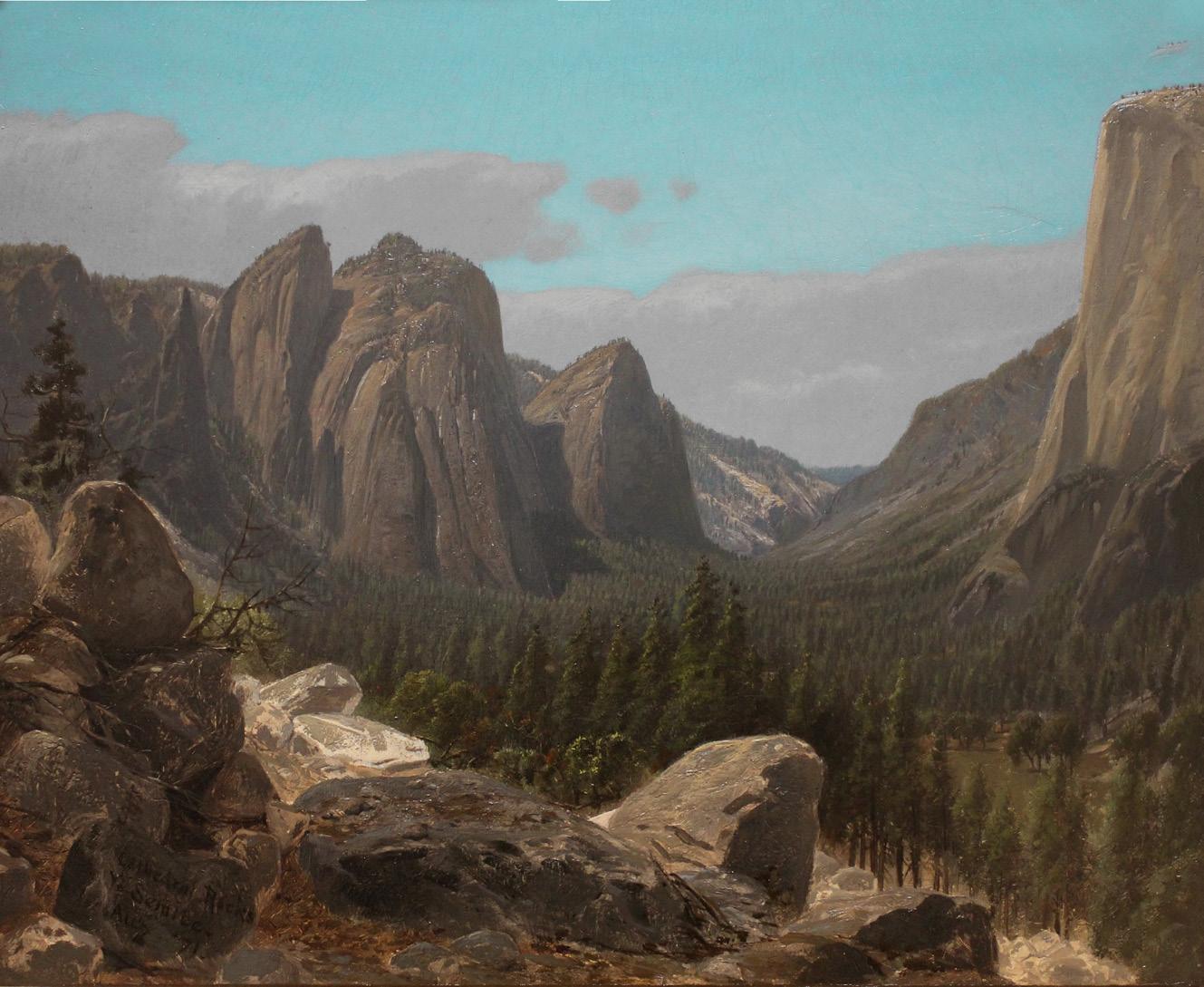
Cathedral Rocks Yo-Semite
Oil on canvas; 1871; signed in pigment with the artist’s monogram JDS in the lower left; inscribed in pigment in the lower left: “Cathedral Rocks / Yo-Semite Aug. ‘71”; 13-1/4 x 16-1/4 inches image. This is one of the earliest paintings of Yosemite. In June 1864, President Lincoln signed legislation giving Yosemite Valley to the state of California. The Yosemite Grant included the first parkland the federal government set aside for preservation. Yosemite was granted National Park status in 1890.
Inventory: BC232
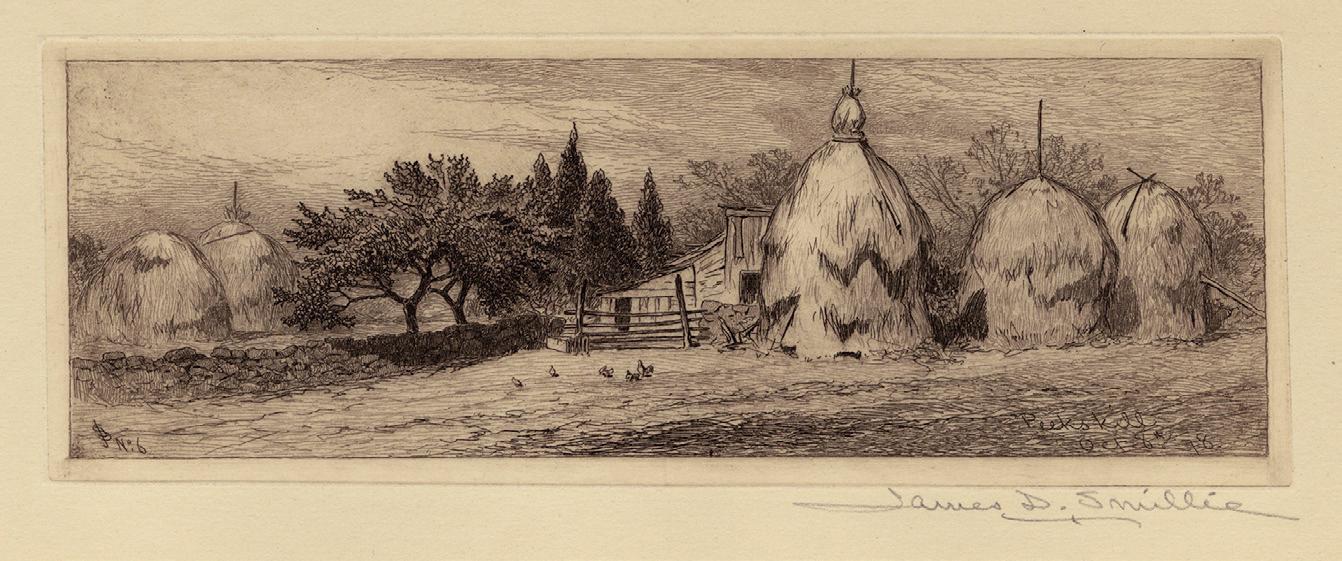
Hay Ricks Near Peekskill
Etching; 1878; reference: Witthoff 6; pencil signed in lower right; incised in plate in lower left: “J D S No. 6” and “Peekskill / Oct 8th ‘78”; number of impressions is unknown; printed by the artist on cream wove paper; 2-3/8 x 6-1/2 inches platemark.
Inventory: BC001
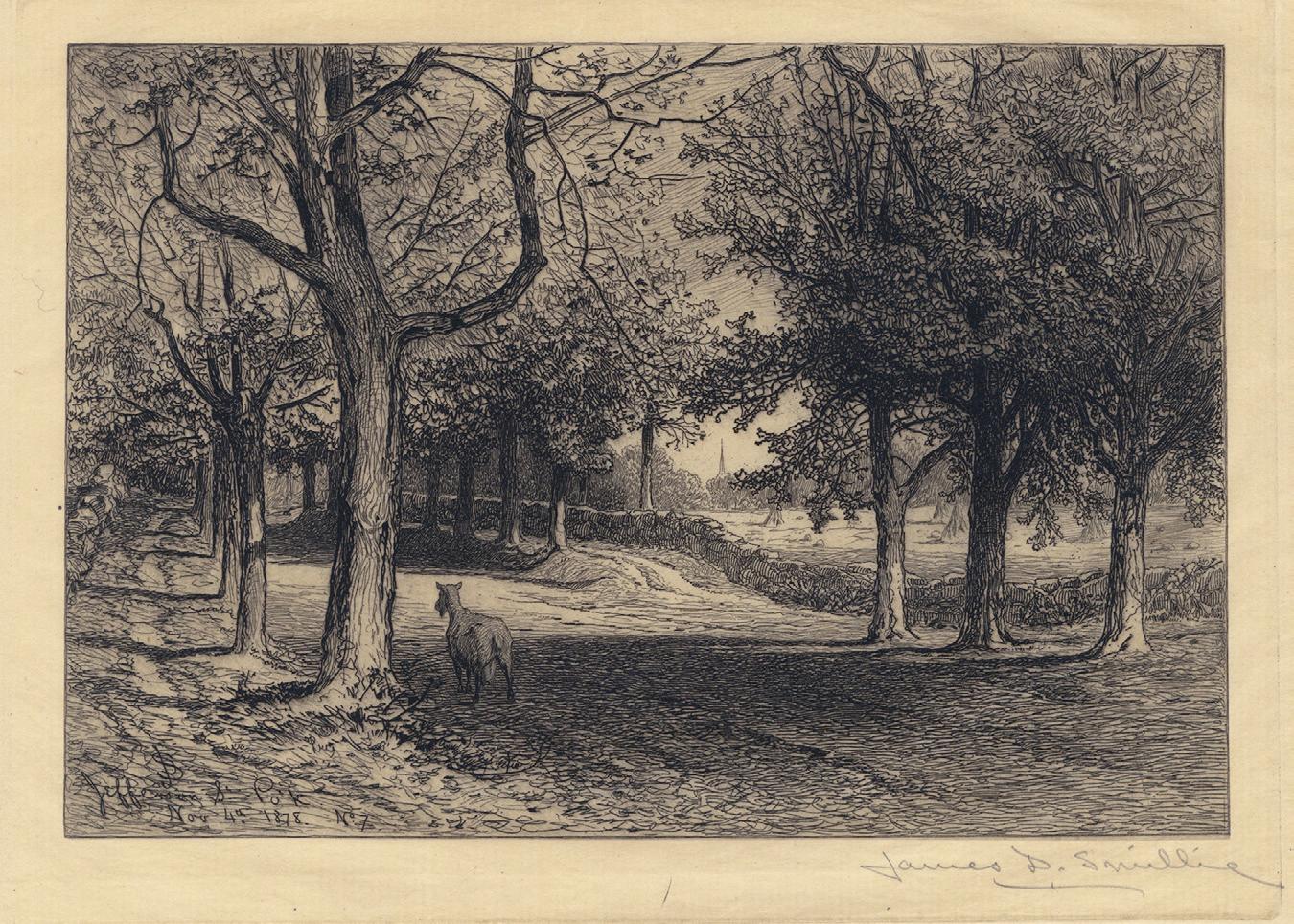
South Jefferson Street, Poughkeepsie No. 1
Etching; 1878; reference: Witthoft 8; pencil signed; incised in the plate in lower left: “J. D. S. / Jefferson St. Po’k / Nov 4th 1878 No 7”; edition unknown; printed by the artist on fine, cream laid paper; 5-3/8 x 7-3/8 inches platemark.
Inventory: BC020
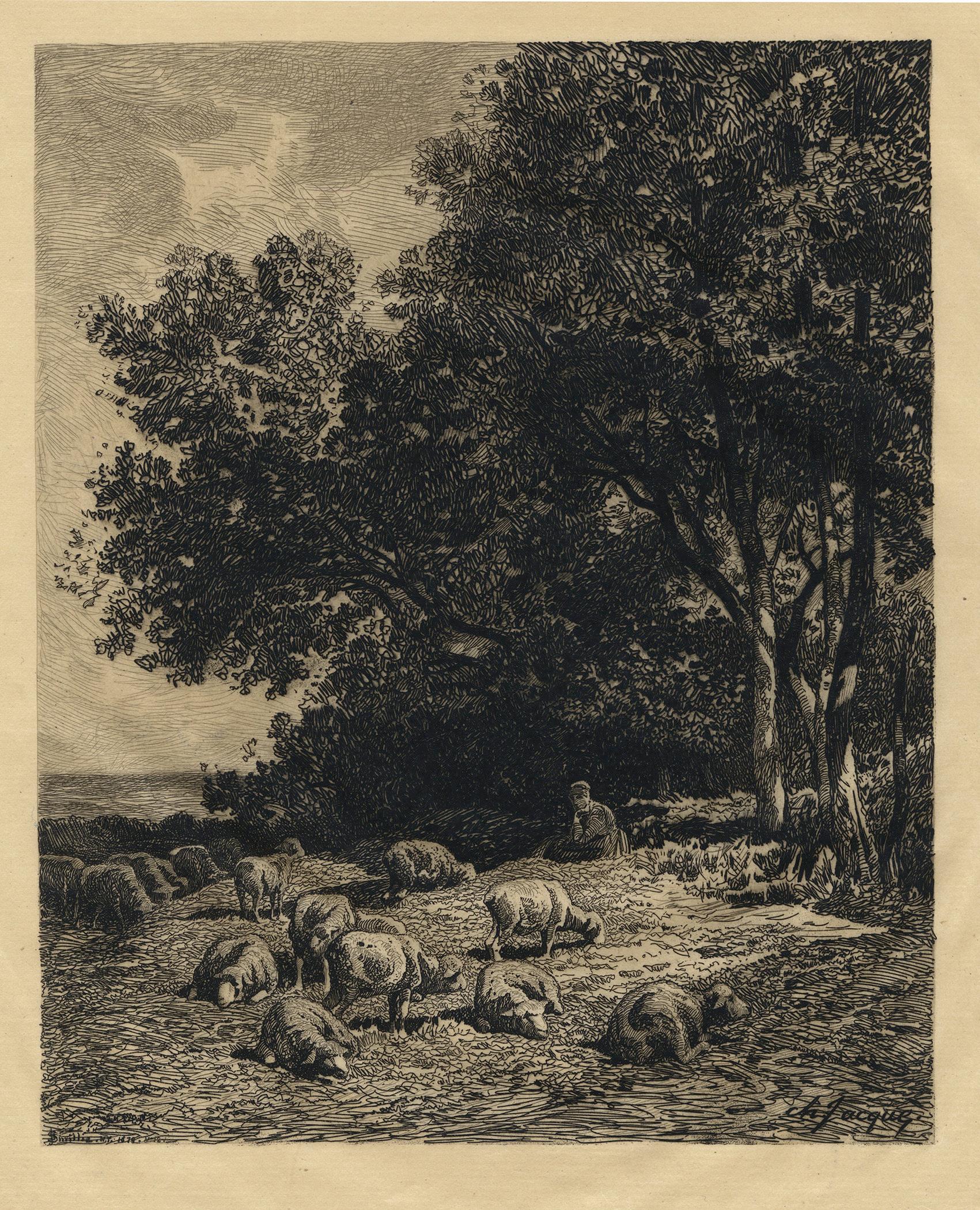
Landscape with Sheep, after Charles Jacque
Etching; 1879; reference: Witthoff 13; unsigned proof; incised in the plate “J. D. Smillie NY 1879 No 12” in lower left and “Ch Jacque” in lower right; printed by the artist on fine, ivory laid paper; published in American Art Review, Vol. 1 No. 1, November 1879; 7-7/8 x 6-3/8 inches platemark. According to Witthoff, Smillie wrote in his diary on 21 July 1879, that S. R. Koehler called “my Jacque...a glorious piece of work and he defies any Frenchman to beat it.”
Inventory: BC119
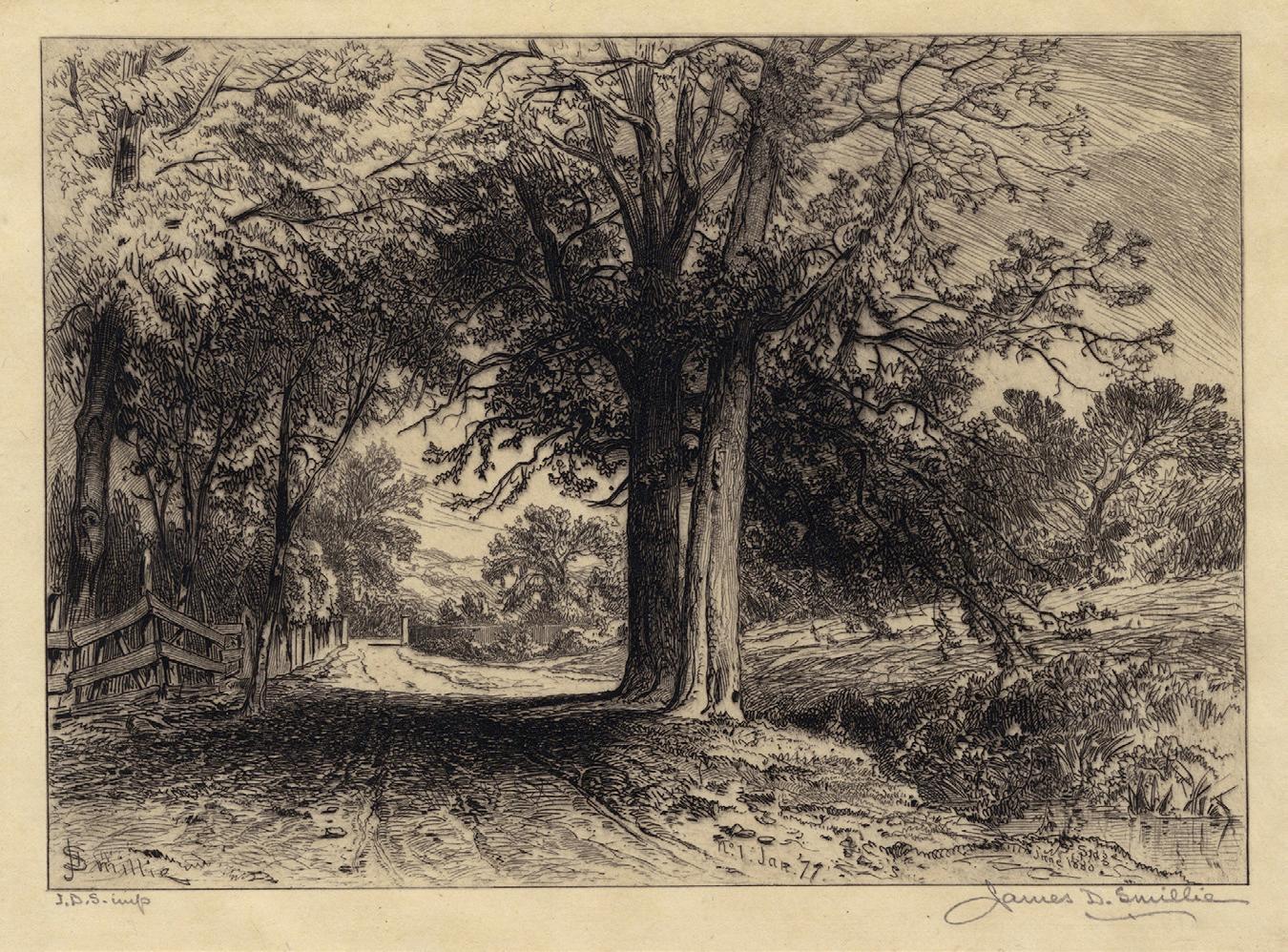
A Farm Lane
Etching; 1879/1880; reference: Witthoff 2; state iii/iii; pencil signed and inscribed “J. D. S. imp” in the lower left and “3rd State” at the lower sheet edge; incised in the plate in the lower center “No. 1. Jan ‘79” and “3 stage / June 1880” in the lower right; printed by the artist on ivory wove paper; 5-7/16 x 7-1/4 inches platemark.
Inventory: BC069
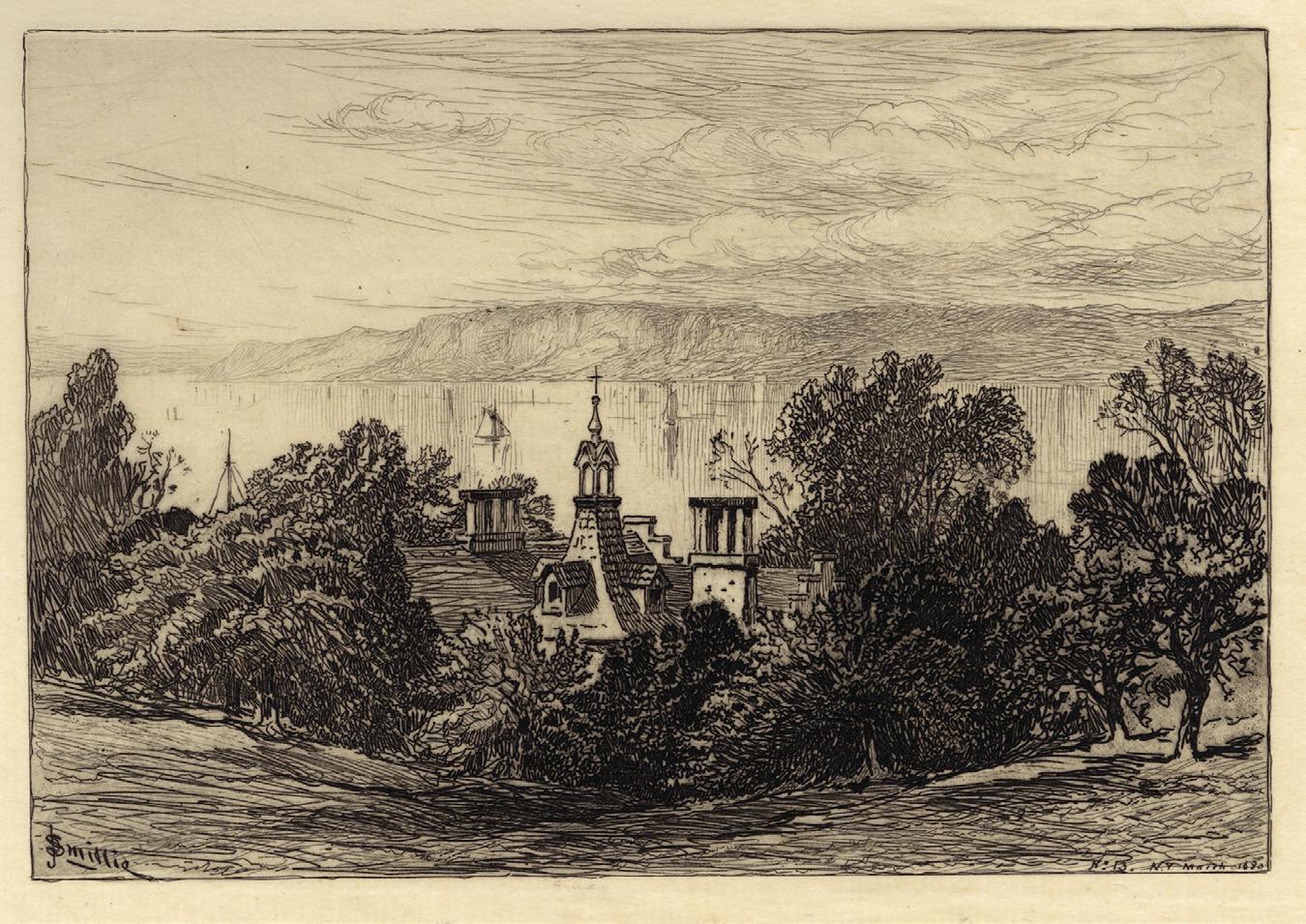
Sunnyside, Irvington
Etching; 1880; reference: Witthoff 15; state ii/ii; unsigned proof; incised in the lower plate “J. D. Smillie” and “No. 13 NY March 1880”; printed by the artist on fine, cream laid paper; published as a bookplate in an edition of the works of Washington Irving, published by G. P. Putnam; 4-1/8 x 6 inches platemark.
Inventory: BC005

Old Cedars, Coast of Maine
Etching; 1880; reference: Witthoff 17; state i/ii; unsigned proof; incised in the plate in lower left “J D Smillie” and in the lower right “Old Cedars / Coast of Maine / No 15 Ap 1880”; printed by the artist on fine, ivory laid paper; published in American Art Review, Vol. 1 no. 12, Oct. 1880; 5 x 6-15/16 inches platemark. Witthoff notes that in 1882 the well-known German etcher, H. F. E. von Schennis copied Smillie’s etching and represented the image as his own. The original and the copy were exhibited side-by-side at the NY Etching Club in 1885. Inventory: BC209
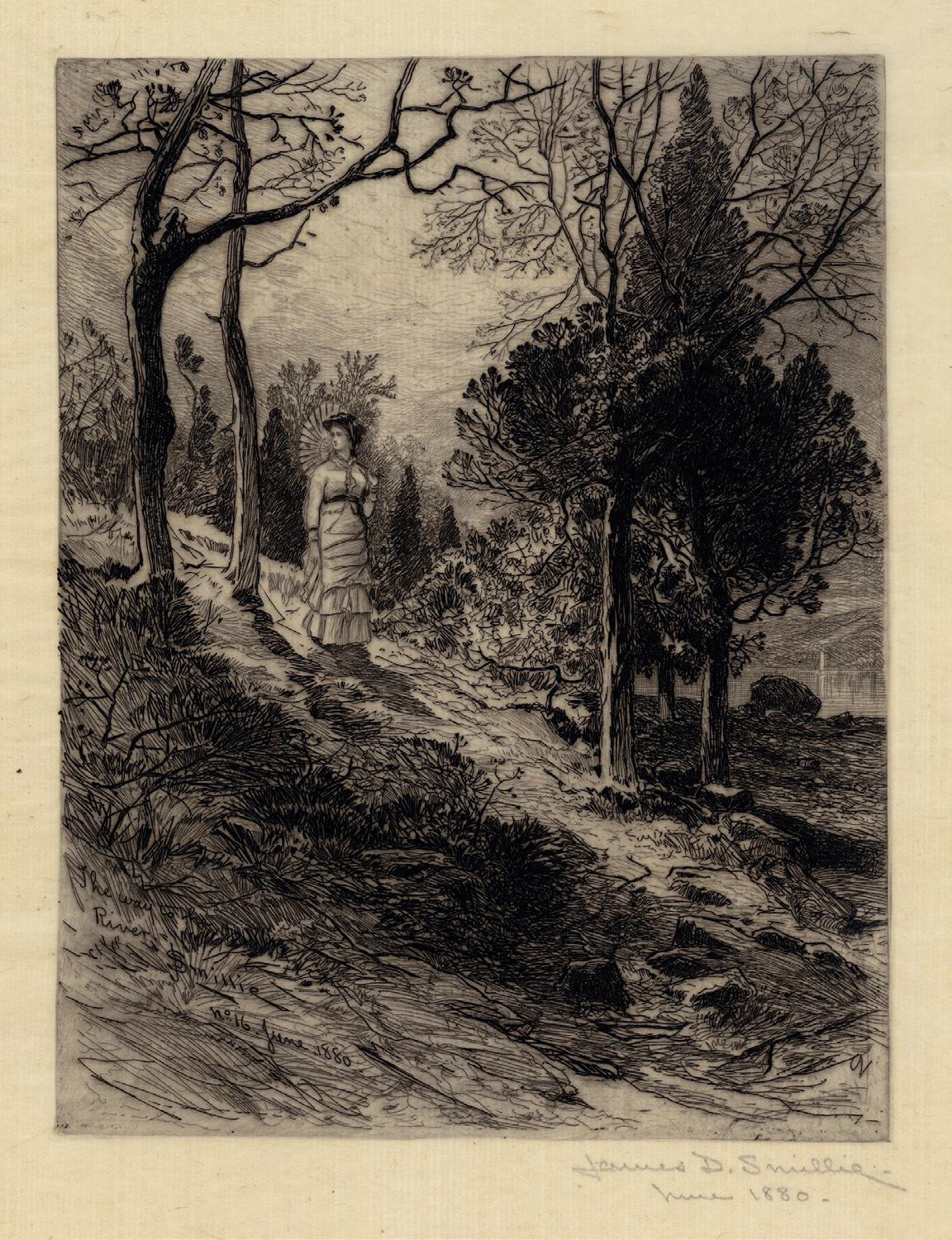
The Way to the River
Etching; 1880; reference: Witthoff 18; pencil signed and dated “June 1880”; rare proof; incised in the plate in the lower left: “The way to the / River / J D Smillie / No 16 June 1880”; printed by the artist on fine, cream laid paper; 7-3/4 x 6 inches platemark. One proof from the artist’s estate was annotated: “Etched for Wunderlich & pub. by him.” According to Witthoff, the figure was probably based upon the model, Miss van Horne.
Inventory: BC173
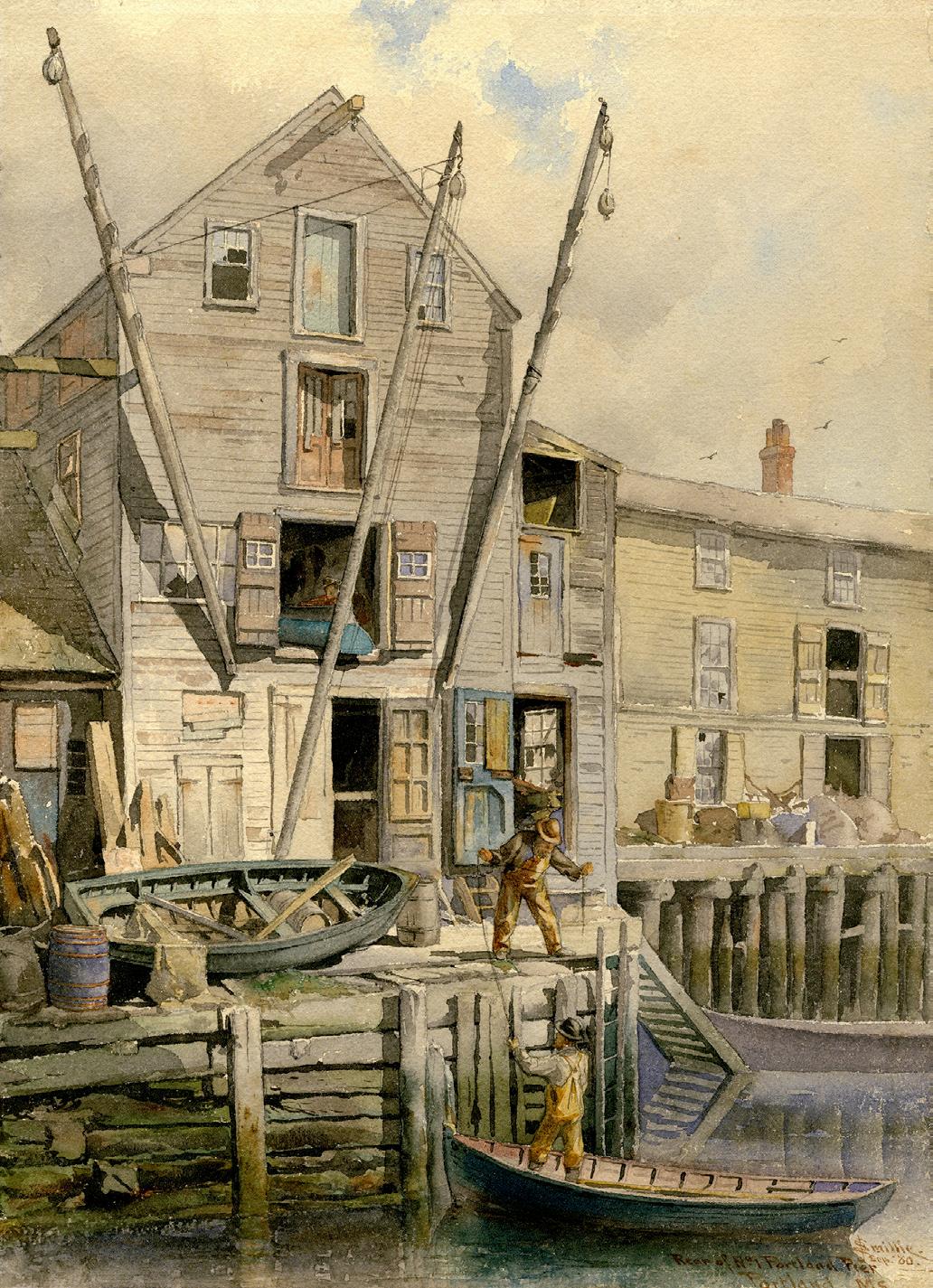
Rear of No. 1 Portland Pier, Maine
Watercolor; 1880; signed in pigment in lower right and dated “Sep. ‘80”; also inscribed in lower right: “Rear of No. 1 Portland Pier / Portland Me”; on textured watercolor paper; 14-1/4 x 10-3/8 inches image size; 14-3/4 x 11 inches paper size.
Inventory: MIKL500
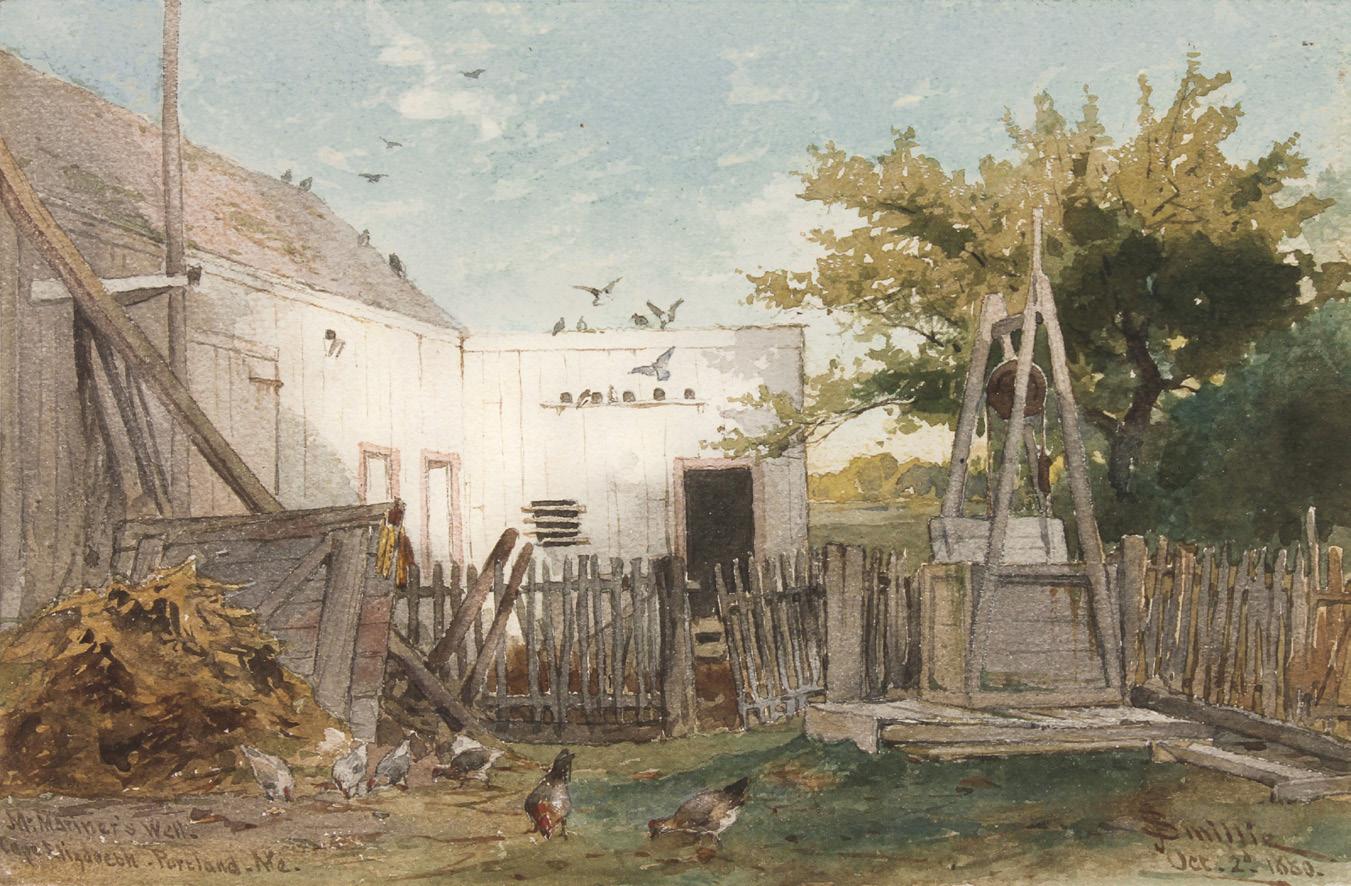
McMariner’s Well. Cape Elizabeth. Portland, ME
Watercolor; 1880; pigment signed: “J. D. Smillie / Oct 22d 1880” in lower right; inscribed in pigment in the lower left: “McMariner’s Well. Cape Elizabeth. Portland, Me”; on ivory, textured watercolor paper; 6-3/4 x 10-1/4 inches image size; 6-7/8 x 10-3/8 inches paper size. Inventory: BC222
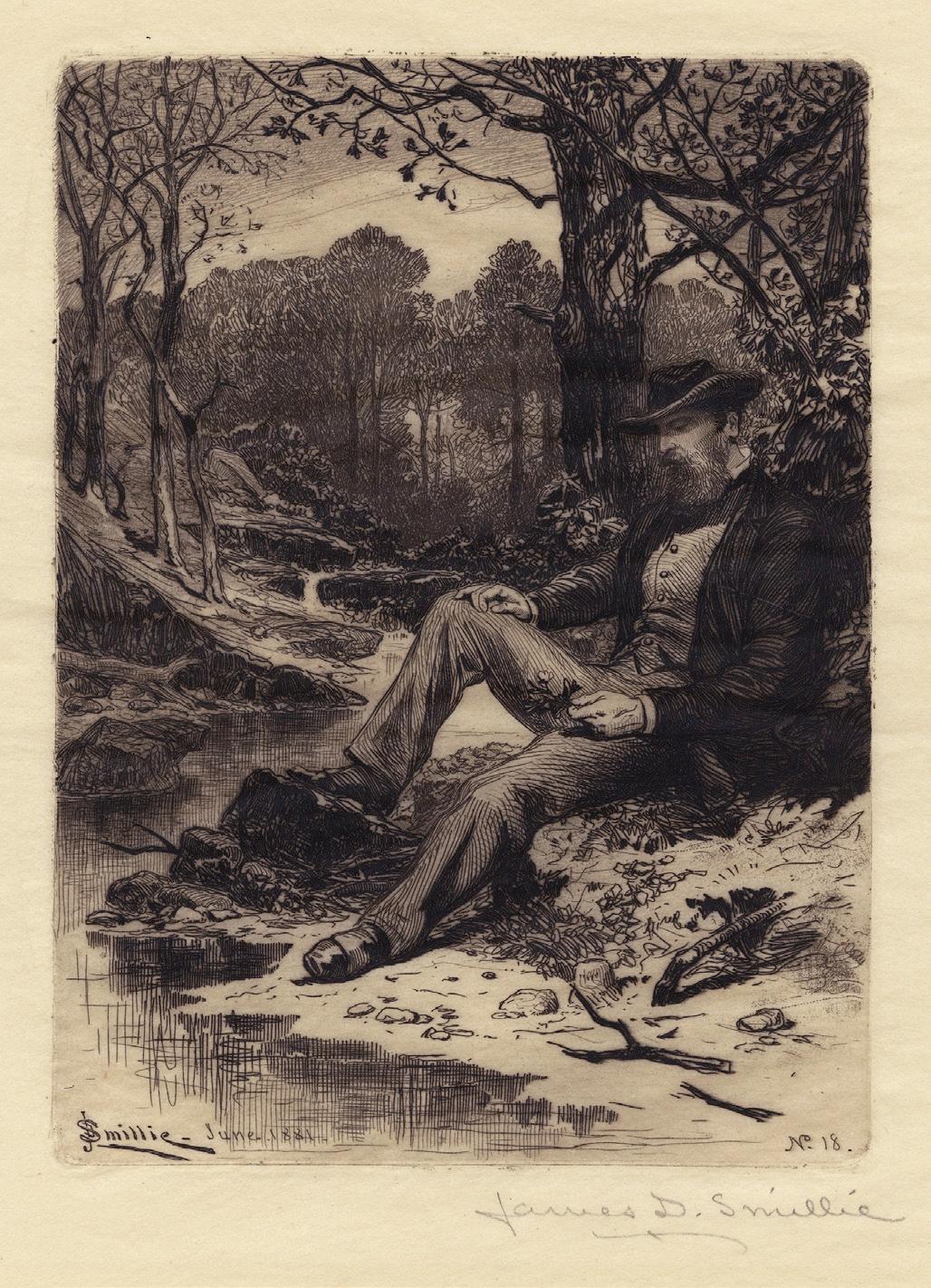
The Apology
Etching; 1881; reference: Witthoff 21; pencil signed in lower right; incised in the lower plate: “J. D. Smillie / June 1881 / No. 18”; proof printed by the artist on fine, ivory laid paper; 7-1/4 x 5-3/8 inches platemark. This etching was published in Poets and Etchers, 1882, and accompanies Ralph Waldo Emerson’s poem of the same title. Inventory: BC122
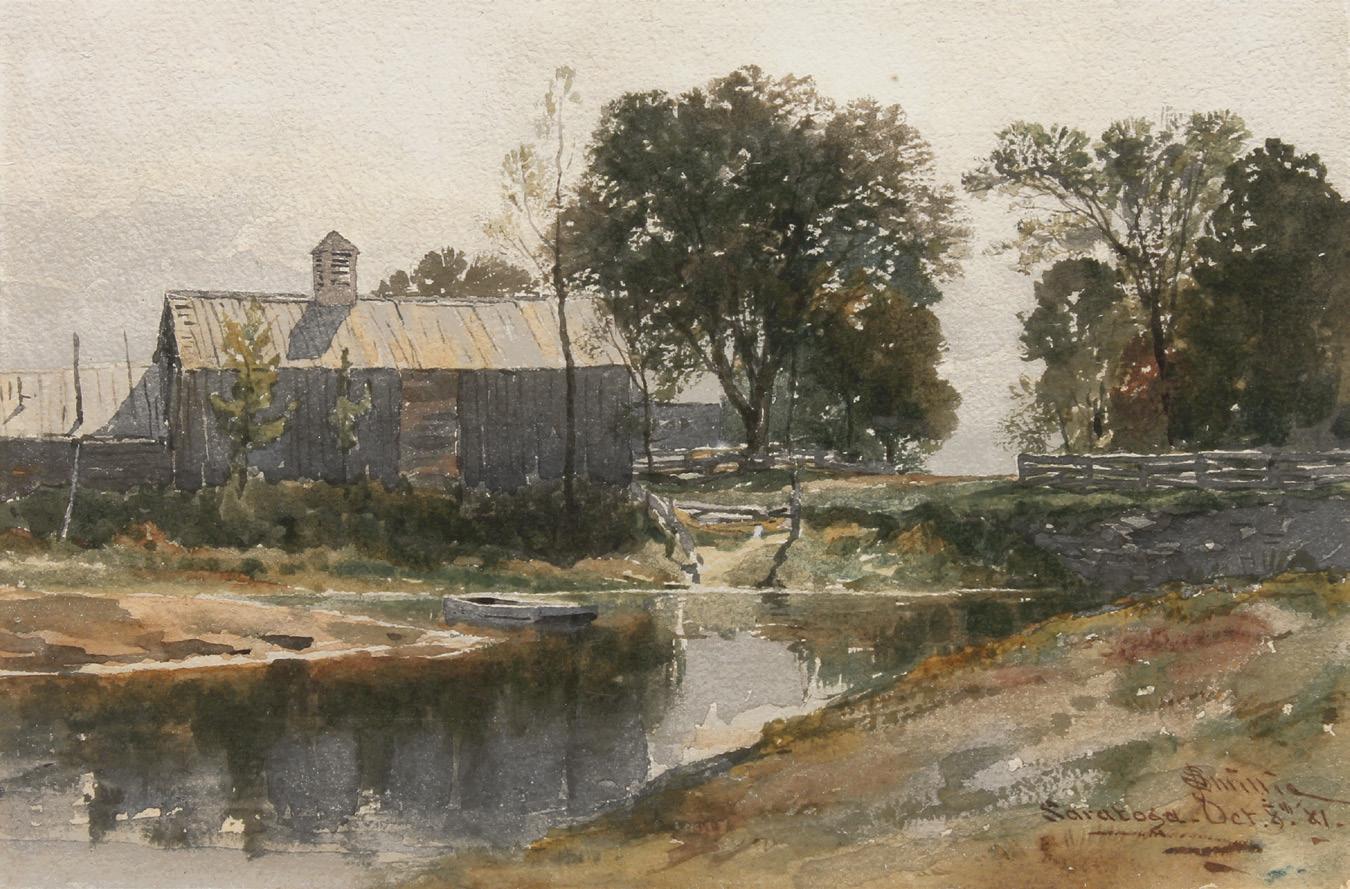
Saratoga
Watercolor; 1881; signed and inscribed in pigment in lower right: “J. D. Smillie / Saratoga Oct. 8th ‘81”; on textured, ivory watercolor paper; 6-3/4 x 10-1/4 inches image size; 6-7/8 x 10-1/2 inches paper size. Inventory: BC221
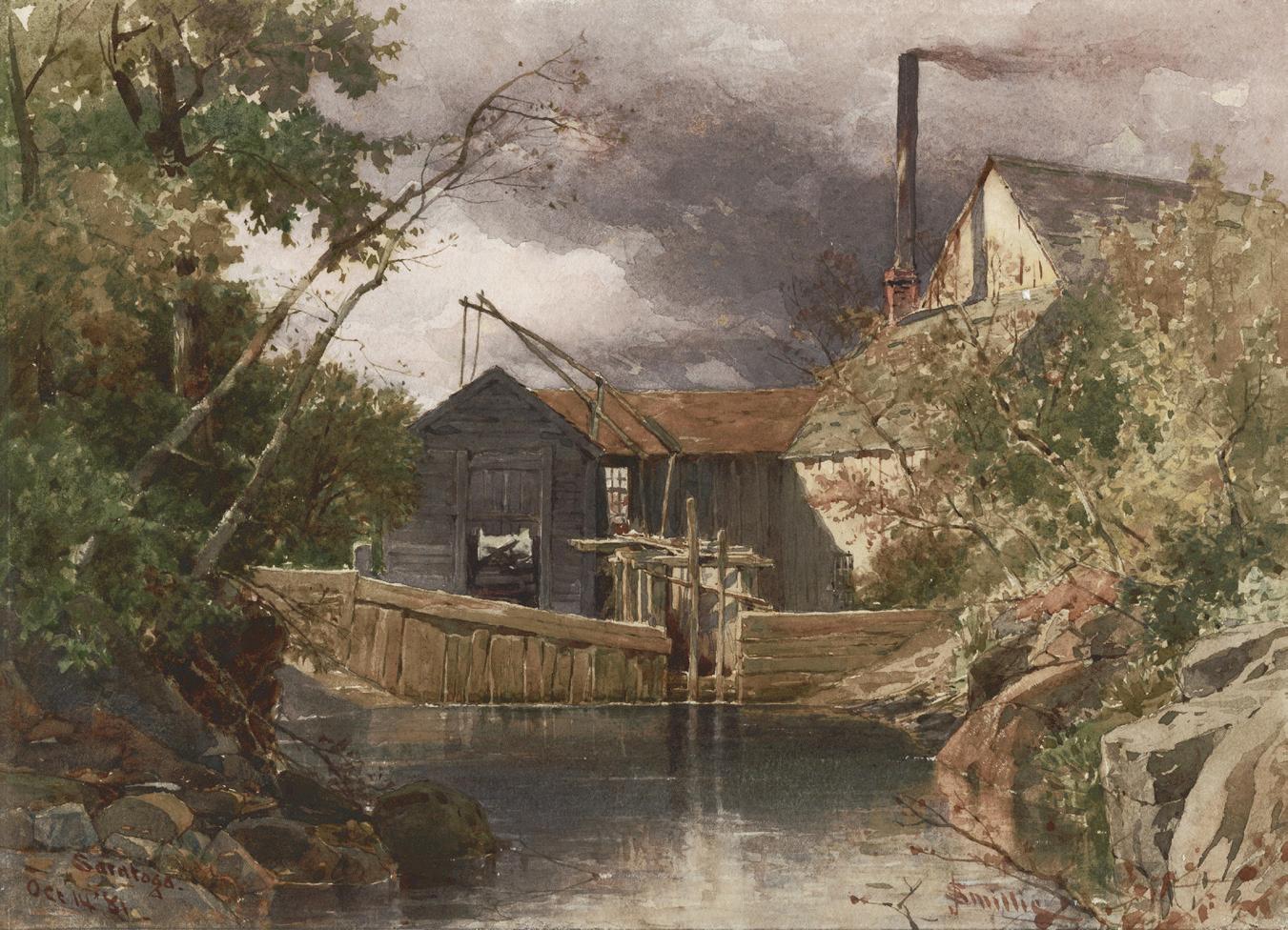
Study of an Old Saw Mill Near Saratoga, New York
Watercolor; 1881; signed “J. D. Smillie” in pigment in lower right; annotated in pigment in lower left: “Saratoga / Oct. 14 ‘81”; on textured, ivory watercolor paper; 9-7/8 x 13-3/4 inches image; 10 x 14 inches paper size; the title had been inscribed on the old paper backing of the frame.
Inventory: BC224
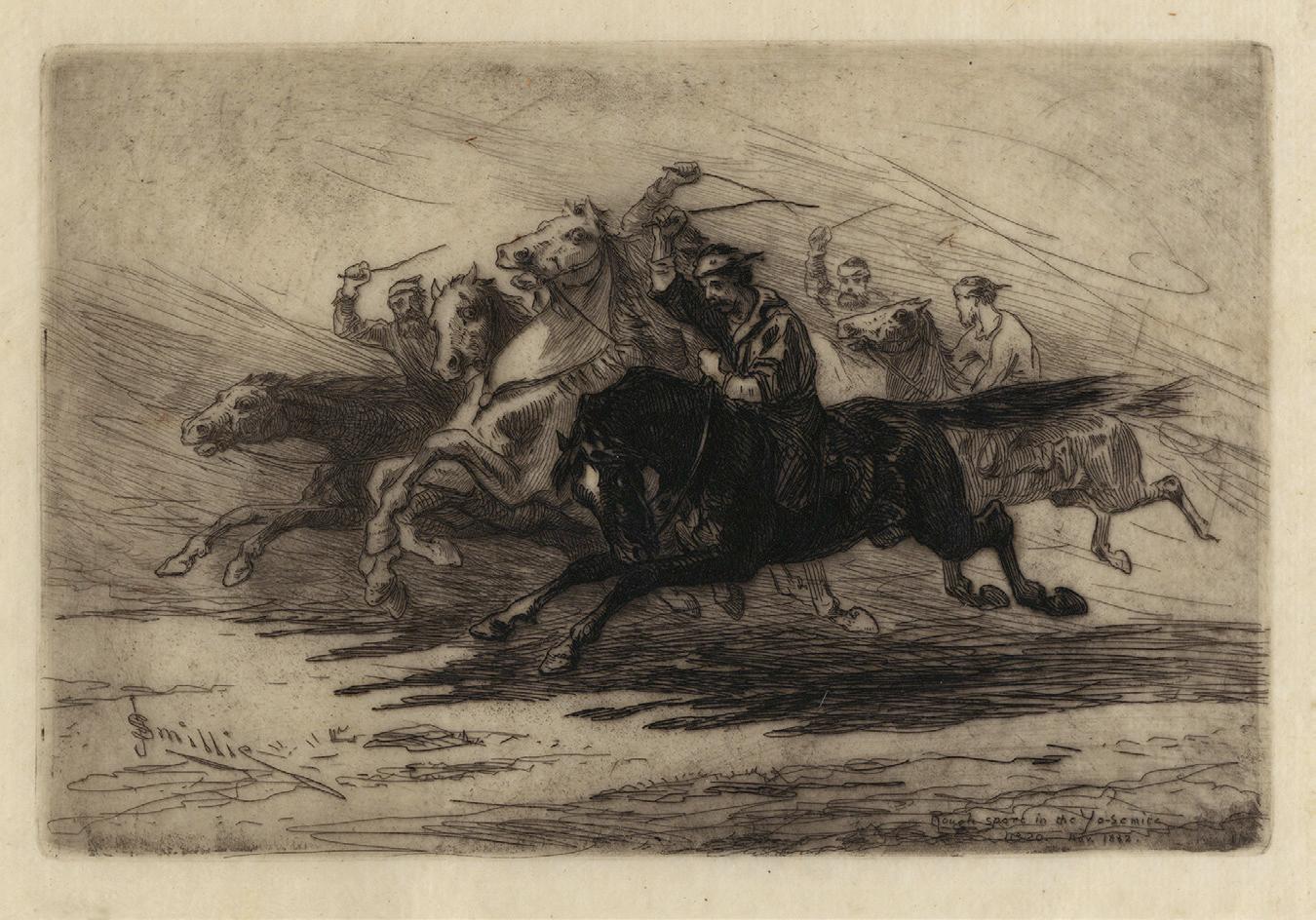
Rough Sport in the Yo-Semite
Etching; 1882; Witthoff 23; unsigned proof; in fact this is the only known proof; incised in plate in lower left “J D Smillie” and in the lower right “Rough Sport in the Yo-semite / No 20 Nov. 1882”; printed by the artist on fine, ivory laid paper; 4-7/16 x 6-3/4 inches platemark. Witthoff notes that this is the first of three etching of the same title but there were different sizes. Smillie described this race: “There were no saddles; the riders...rode with only sheepskin. The word was given; the horses plunged, started, bucked...”.
Inventory: BC218
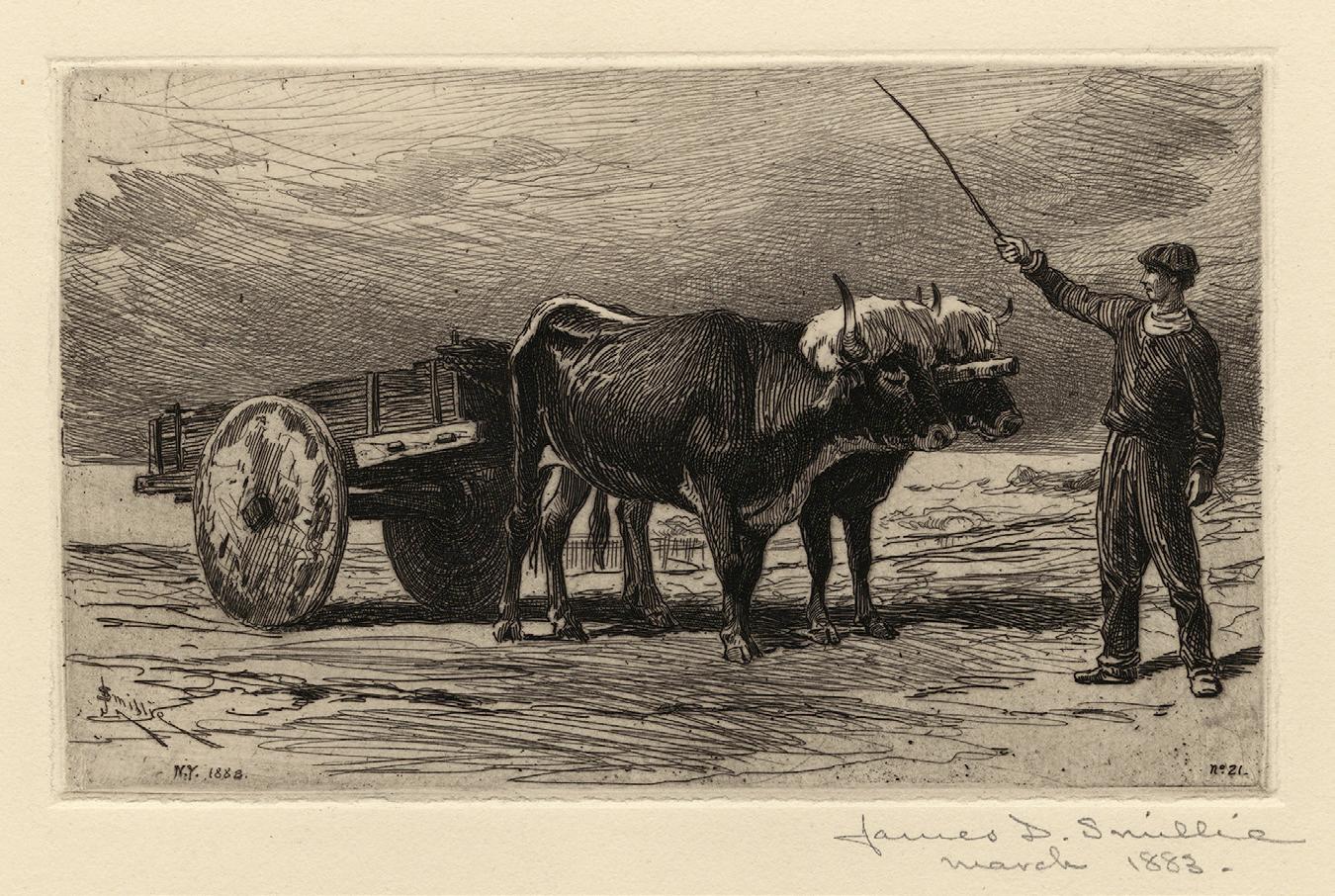
Basque Cart
Etching; 1883; reference: Witthoff 24; pencil signed & dated “March 1883”; proof; incised in the plate at lower edge: “J D Smillie / N.Y. 1883 / No 21”; also pencil inscribed by Smillie in lower right corner of the paper: “Plain print”; printed by the artist on an ivory wove paper; 3-3/16 x 5-3/16 inches platemark. This etching was commissioned by Marvin R. Vincent to illustrated his book, In the Shadow of the Pyrenees.
Inventory: BC016
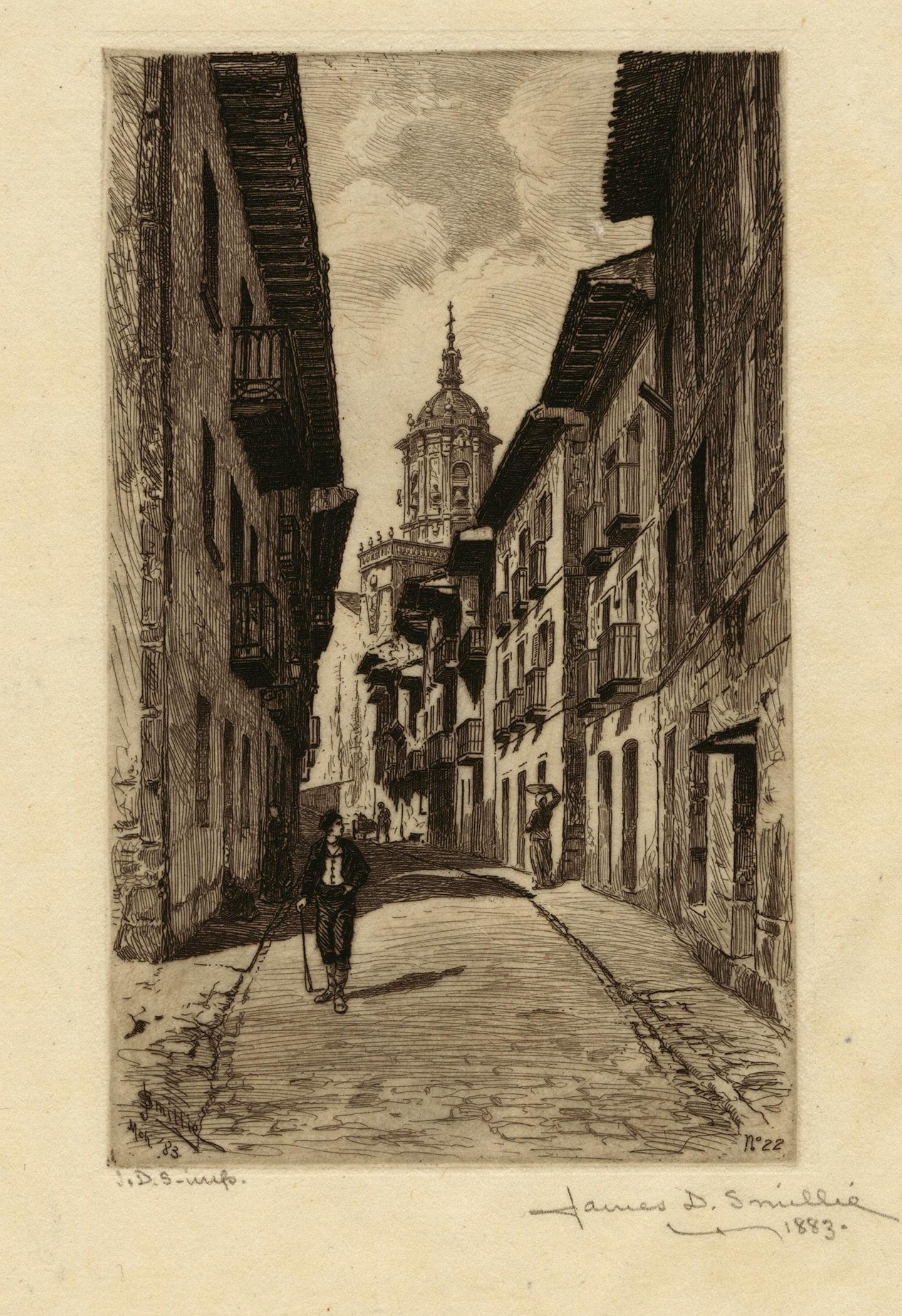
Street in Fontarabia
Etching; 1883; reference: Witthoff 25; pencil signed, dated and inscribed “J. D. S. imp.”; incised in the plate: “J. D. Smilllie / Mch. ‘83” and “No 22”; one of only a few proofs printed by the artist on fine, ivory laid paper; pencil inscribed in lower margin: “Street in Fontarabia / from a photograph”; published in Marvin R. Vincent’s In the Shadow of the Pyrenees, Schribner’s Sons, 1883; 5-1/8 x 3-1/8 inches platemark.
Inventory: BC032
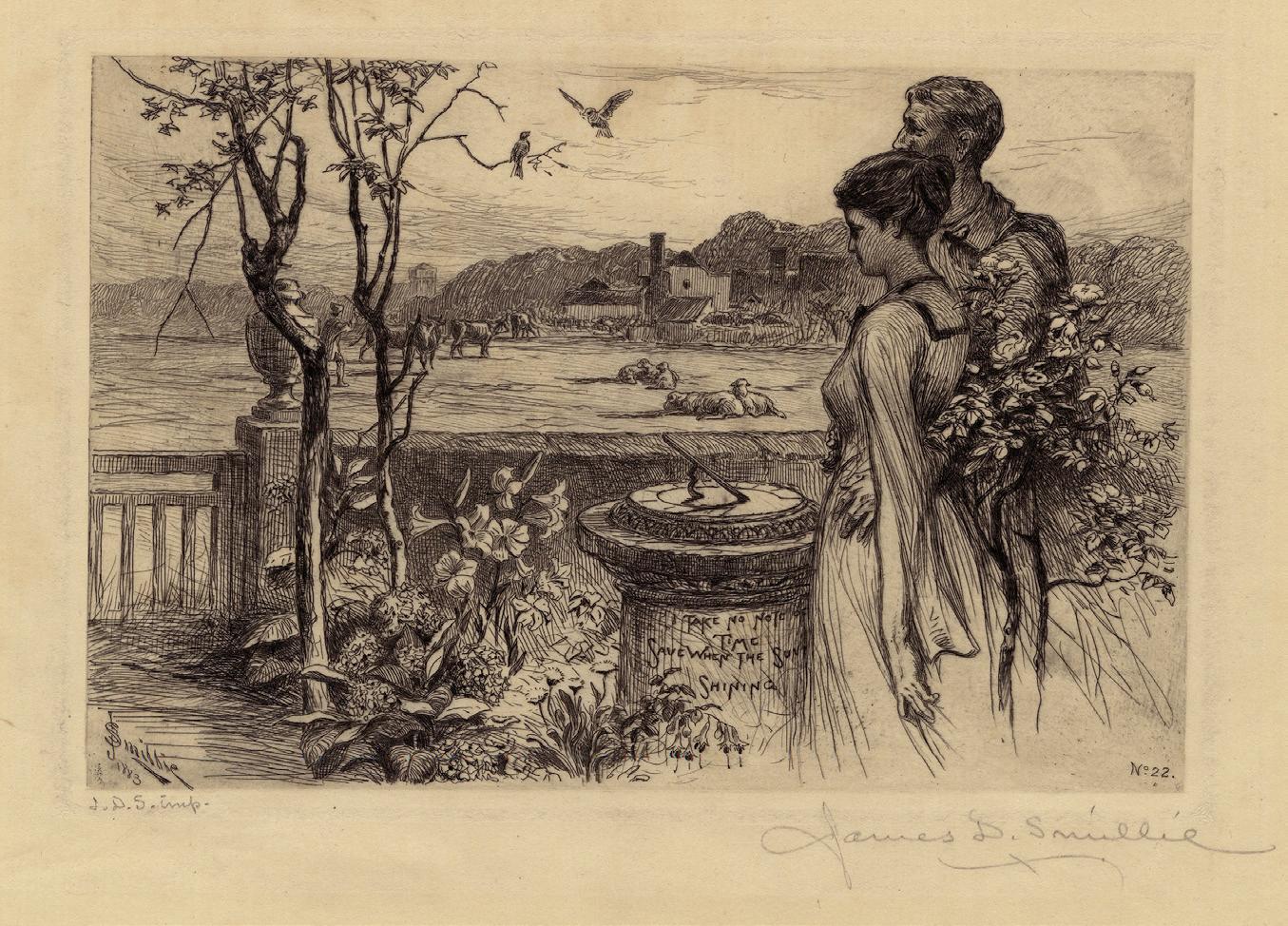
The Sun Dial
Etching; 1883; reference: Witthoff 26; pencil signed and inscribed “J. D. S. Imp.”; proof; incised in the plate “J D Smillie / 1883 / No. 22”; printed by the artist on fine, cream laid paper; commissioned by G. P. Putnam's Sons to illustrate Charles Lamb’s Essays of Elia; 4-5/16 x 6-9/16 inches platemark. Witthoff notes that the models were James’ brother George and his wife Nellie.
Inventory: BC078
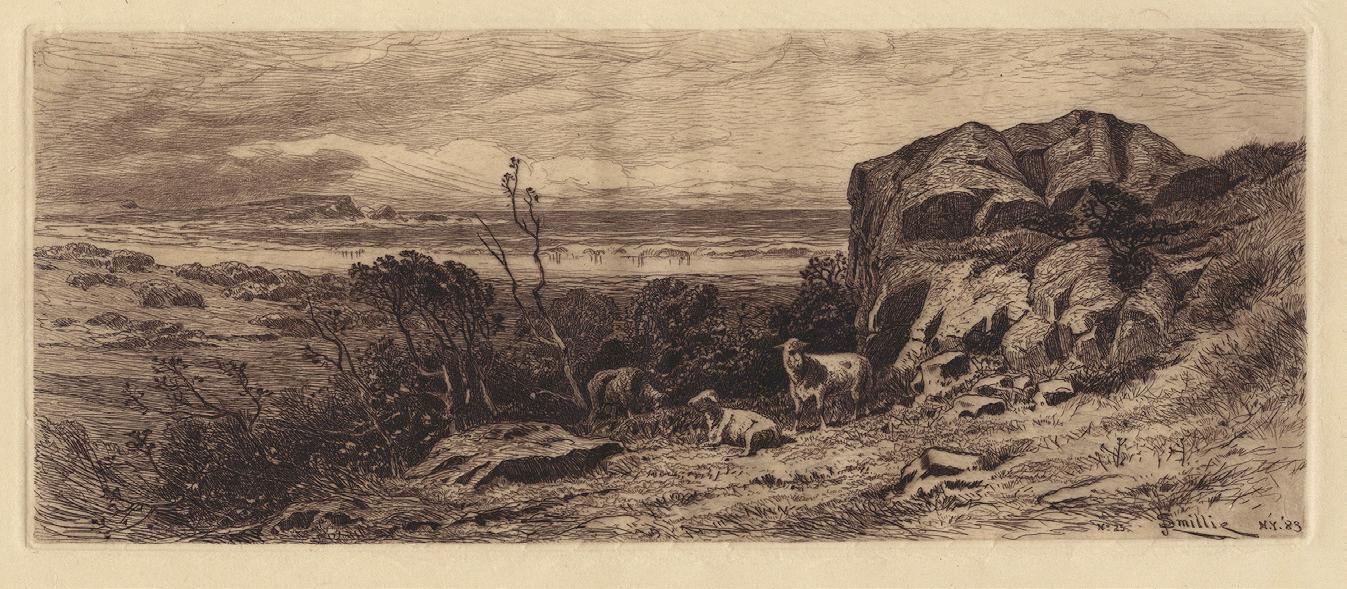
A Bit on Marblehead Neck
Etching; 1883; reference: Witthoff 28; state i/ii; unsigned proof on ivory laid paper; incised in the plate in the lower right: “No. 25 / J. D. Smillie/ N.Y. ‘83”; published by S. R. Koehler in Original Etchings by American Artists, Cassell & Co., New York; 5 x 12-3/16 inches platemark. According to Witthoff, Smillie and his wife, Annie, spent much of September 1882 at Marblehead Neck in Massachusetts. Besides this etching, Smillie created watercolors, and pencil and oil sketches of this location.
Inventory: BC214
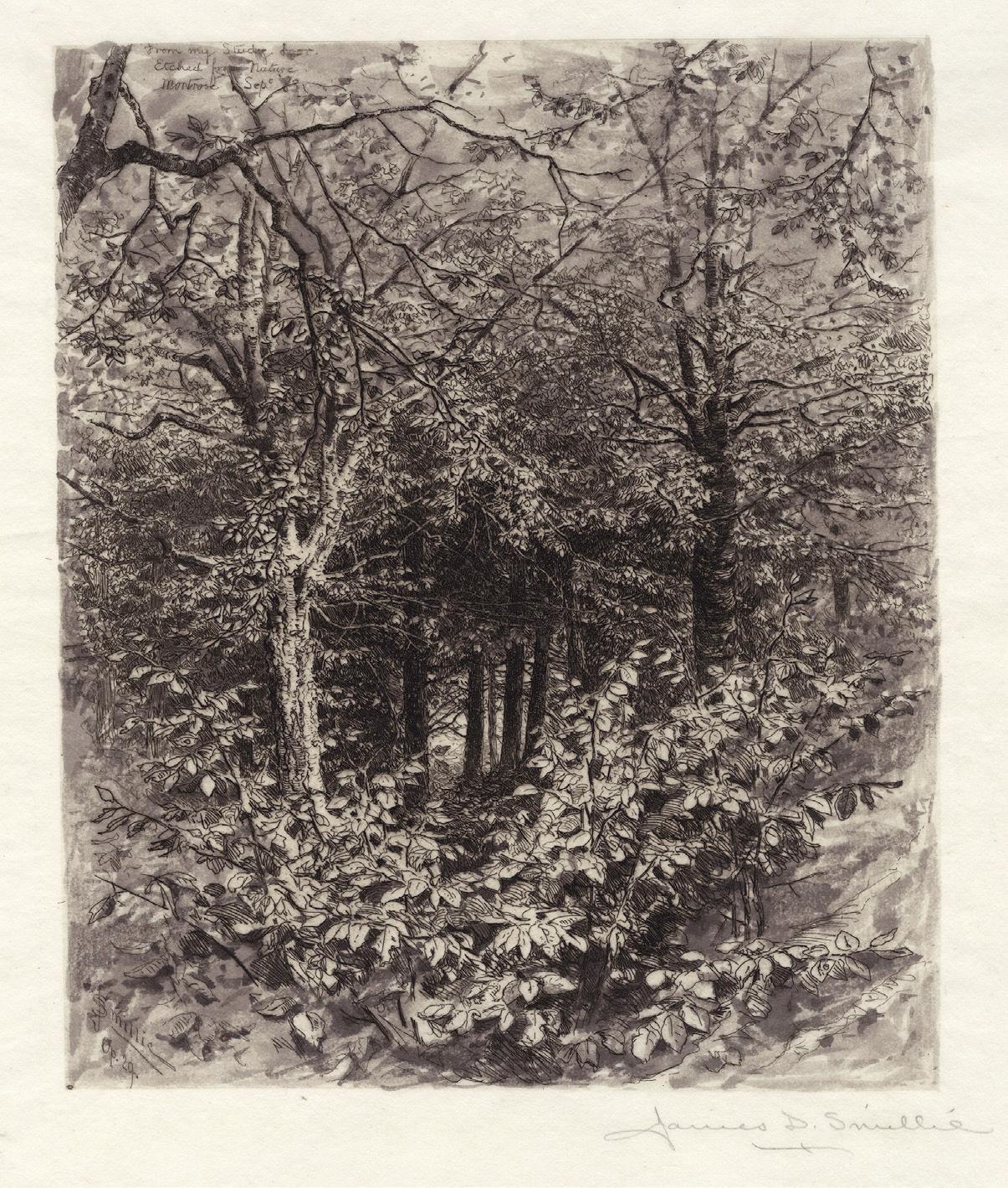
From My Study Door
Etching with watercolor; 1883; reference: Witthoff 32; pencil signed; unique proof; incised in plate in upper left: “From my Study door / Etched from Nature / Montrose Sept ‘83”; further incised in lower left plate: “J. D. Smillie / Op. 29.”; printed by the artist on fine, ivory laid paper; 9-1/16 x 7-5/8 inches platemark. Smillie’s studio was located in Montrose, Pennsylvania. Inventory: 17114
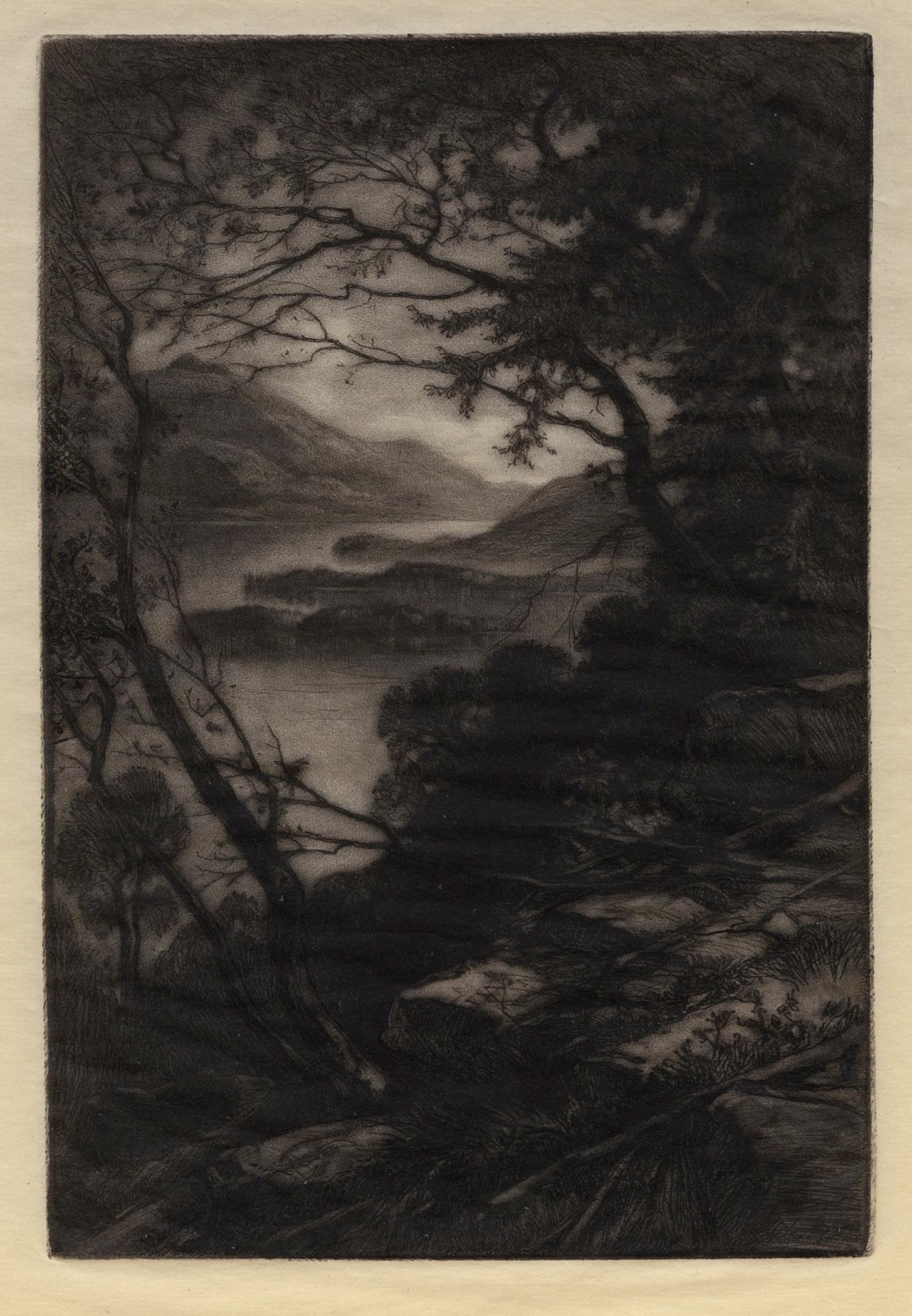
Lake George from Deer’s Leap
Etching and mezzotint; 1883; reference: Witthoff 30; state iii/iii; this proof was printed posthumously by Robert J. Hulse in 1911 after the plate was mezzotinted; only known proof; pencil inscribed in unknown hand in lower left corner of the paper: “Robt. J. Hulse imp. March 24th, 1911”; illustrated on page 125 in The Fine Art Etchings of James David Smillie; on fine, cream wove paper; 6-1/2 x 4-7/16 inches platemark.
Inventory: BC027
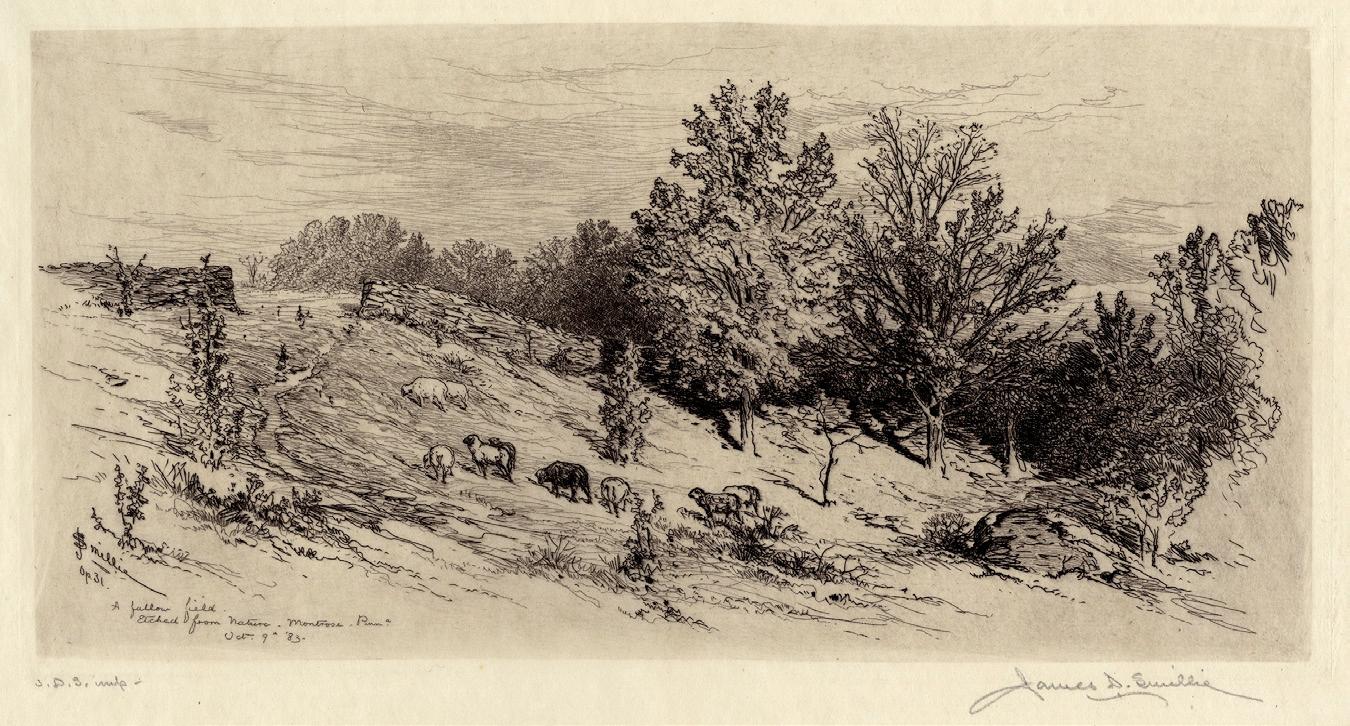
A Fallow Field
Etching; 1883; reference: Witthoff 34; pencil signed and inscribed “J. D. S. imp.”; also titled in pencil in the lower left margin; incised in the plate in the lower left: “J. D. Smillie / Op. 31 / A fallow field / Etched from nature. Montrose, Penn. / Oct., 9th ‘83”; proof printed by the artist on fine, ivory laid paper; 6-1/8 x 12 inches platemark. This etching was published by S. R. Koehler in Etching, An Outline of its Technical Processes and its History, 1885. Inventory: BC127
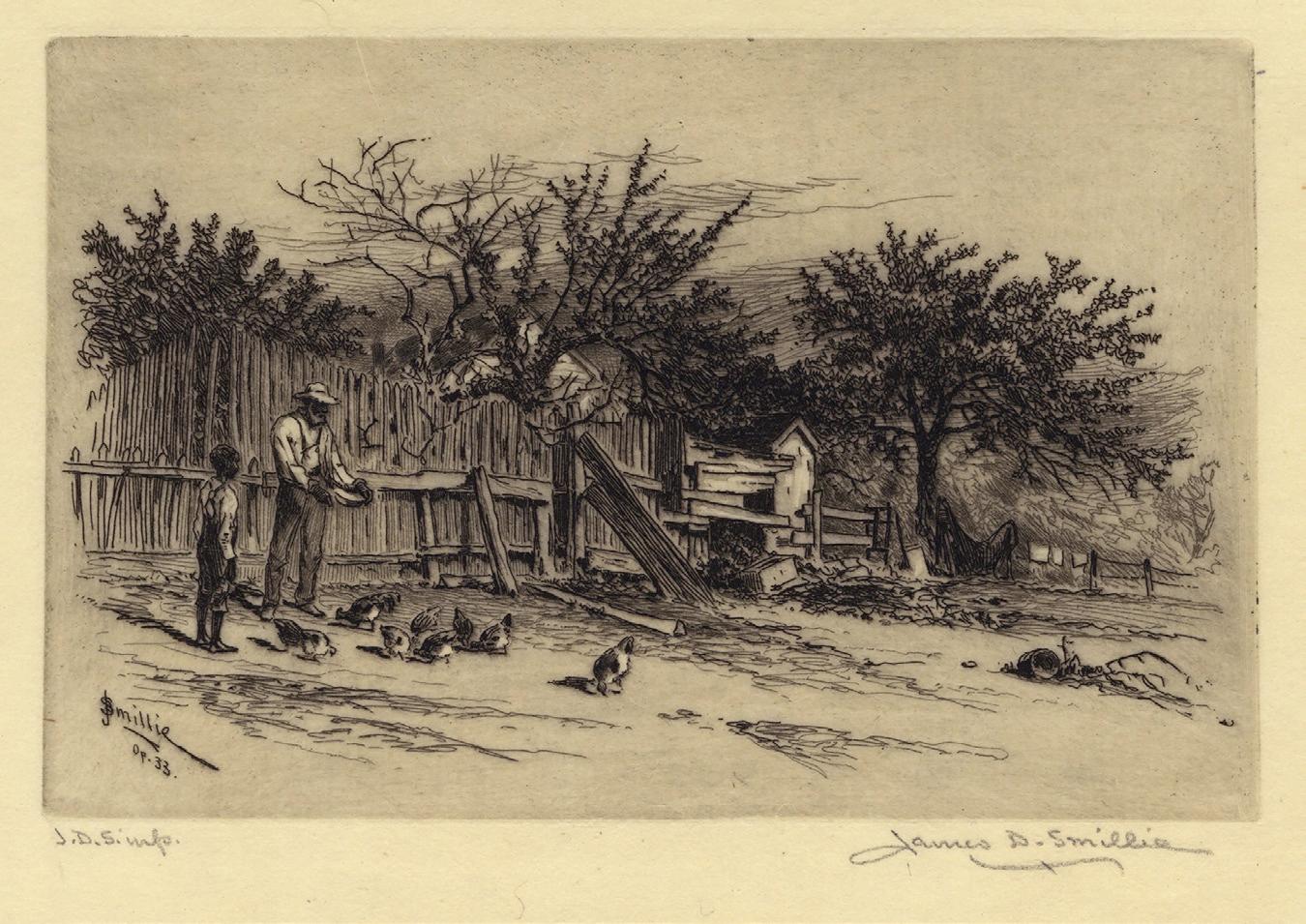
My Colored Neighbor’s Hen Yard
Etching; 1884; reference: Witthoff 36; pencil signed and inscribed “J. D. S. imp.”; incised in the plate: “J. D. Smillie / Op. 33”; printed by the artist on fine, ivory laid paper; 3-1/8 x 5 inches platemark.
According to Witthoff, this is a smaller version of Smillie’s etching of the same scene from 1883. This is the farm of Smillie’s neighbor Azur Lathrop, whose Black farmworker lived behind the main house amid the outbuildings and apple trees.
Inventory: BC219
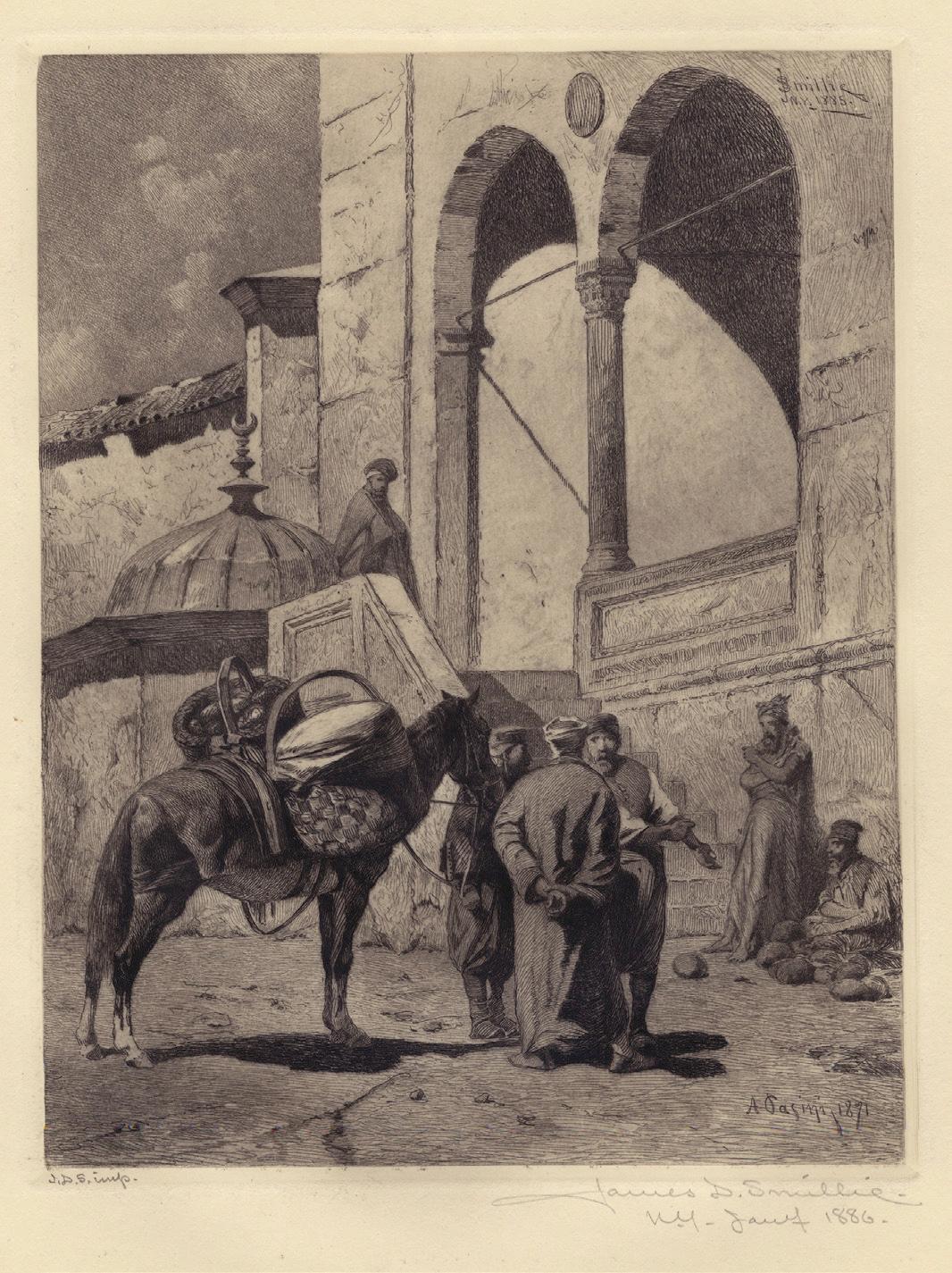
A Courtyard in Constantinpole, after Alberto Pasini
Etching; 1885; reference: Witthoff 41; pencil signed in the lower right and inscribed: “N.Y. Jan 7 1886”; also pencil inscribed in the lower left: “J. D. S. imp.”; incised in the plate in the upper right: “J. D. Smillie / N.Y. 1885”; printed by the artist on cream wove paper; 8 x 6-1/4 inches platemark; Smillie added pencil inscriptions in the lower margin: “A Courtyard in Constantinople-/ Etched from the original oil painting” and “Publ by Am Art Assn in Edition de Luxe / of the Mary Morgan catalogue”. Inventory: BC062
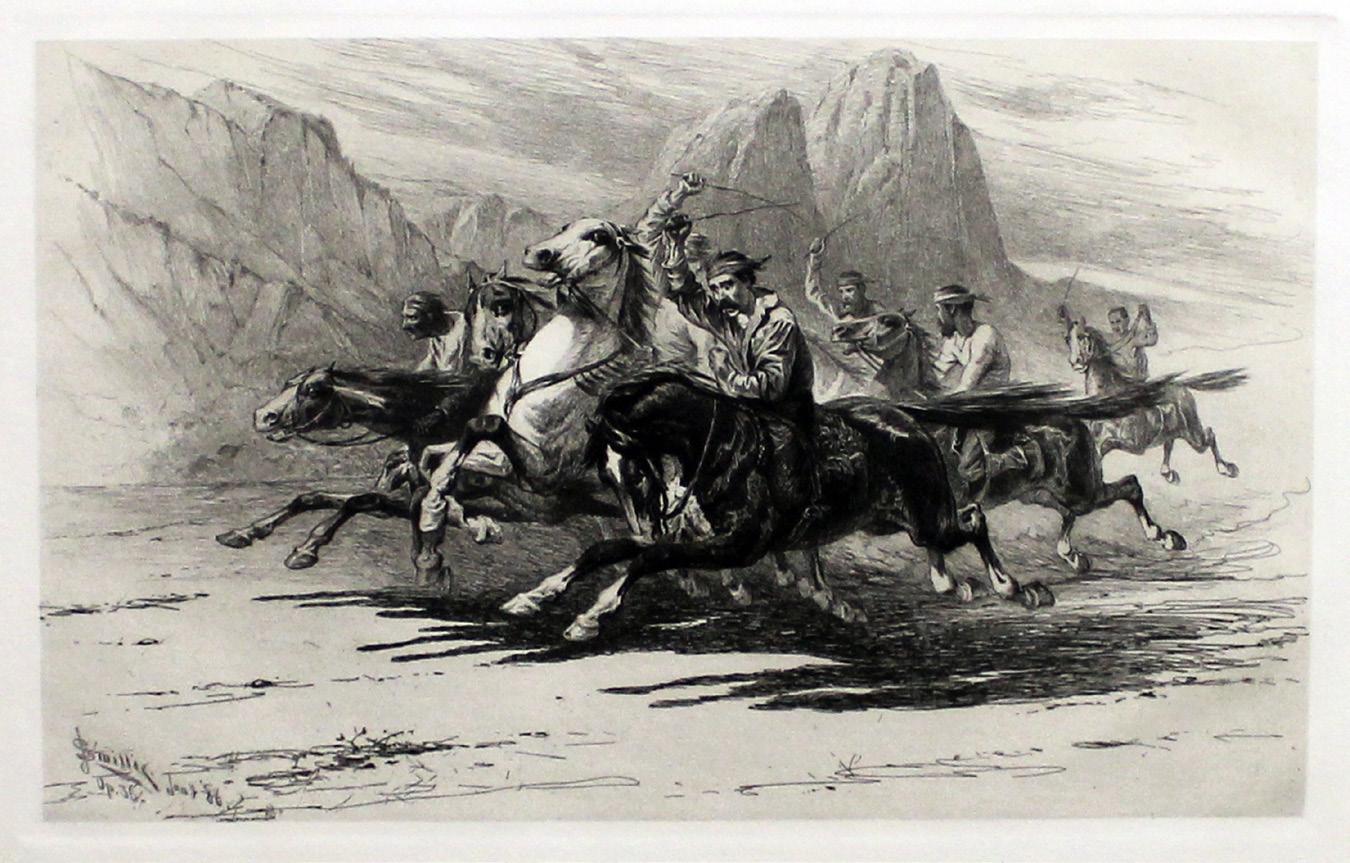
Rough Sport in the Yosemite
Etching; 1886; reference: Witthoff 40; unsigned proof on heavy, ivory J. Whatman wove paper with partial watermark; incised in the plate in lower left: “J. D. Smillie Jan. 7 ‘86 / Op. 36”; 9-3/8 x 15-3/8 inches platemark. This is Smillie’s third etching depicting a horse race that he witnessed during his visit to Yosemite in 1871 and wrote about in length in Picturesque America. Smillie’s description of the race can be found on pages 486-488.
Inventory: BC153

A Hot Bargain
Etching after Frederic A. Bridgman; 1886; reference: Witthoff 44; state ii/ii; pencil signed, dated and inscribed “J.D.S. Imp.”; proof; incised in the plate in the upper left: “J. D. Smillie / aqua-fortis / 1886”; in the lower right is incised: “F. A. Bridgman 1884”; printed by the artist on fine, ivory laid paper; 5-7/8 x 9 inches platemark. The scene is a horse market in Cairo.
Inventory: BC133
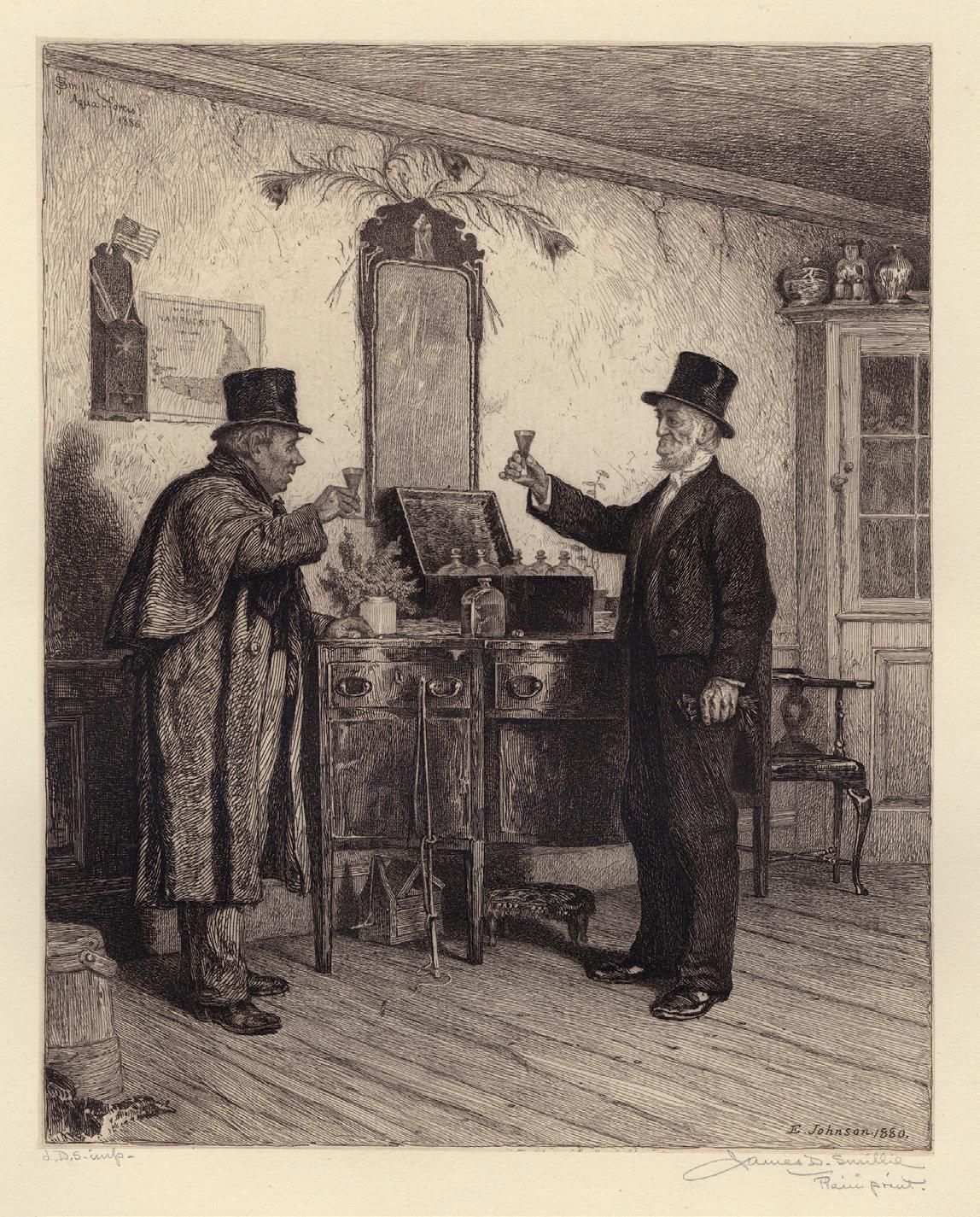
A Glass with the Squire, after Eastman Johnson
Etching; 1886; reference: Witthoff 45; state ii/iii, before the addition of drypoint; pencil signed and inscribed “Plain print.” in the lower right and “J. D. S. Imp-” in lower left; plate incised in upper left: “J D Smillie / Aqua Fortis/ 1886”; printed by the artist on a sturdy, cream wove paper; 8-5/16 x 6-3/4 inches image; 10-1/2 x 8-1/2 inches platemark. According to Witthoff, Johnson was so pleased with Smillie’s completed etching that he signed a number of proofs. Inventory: BC066
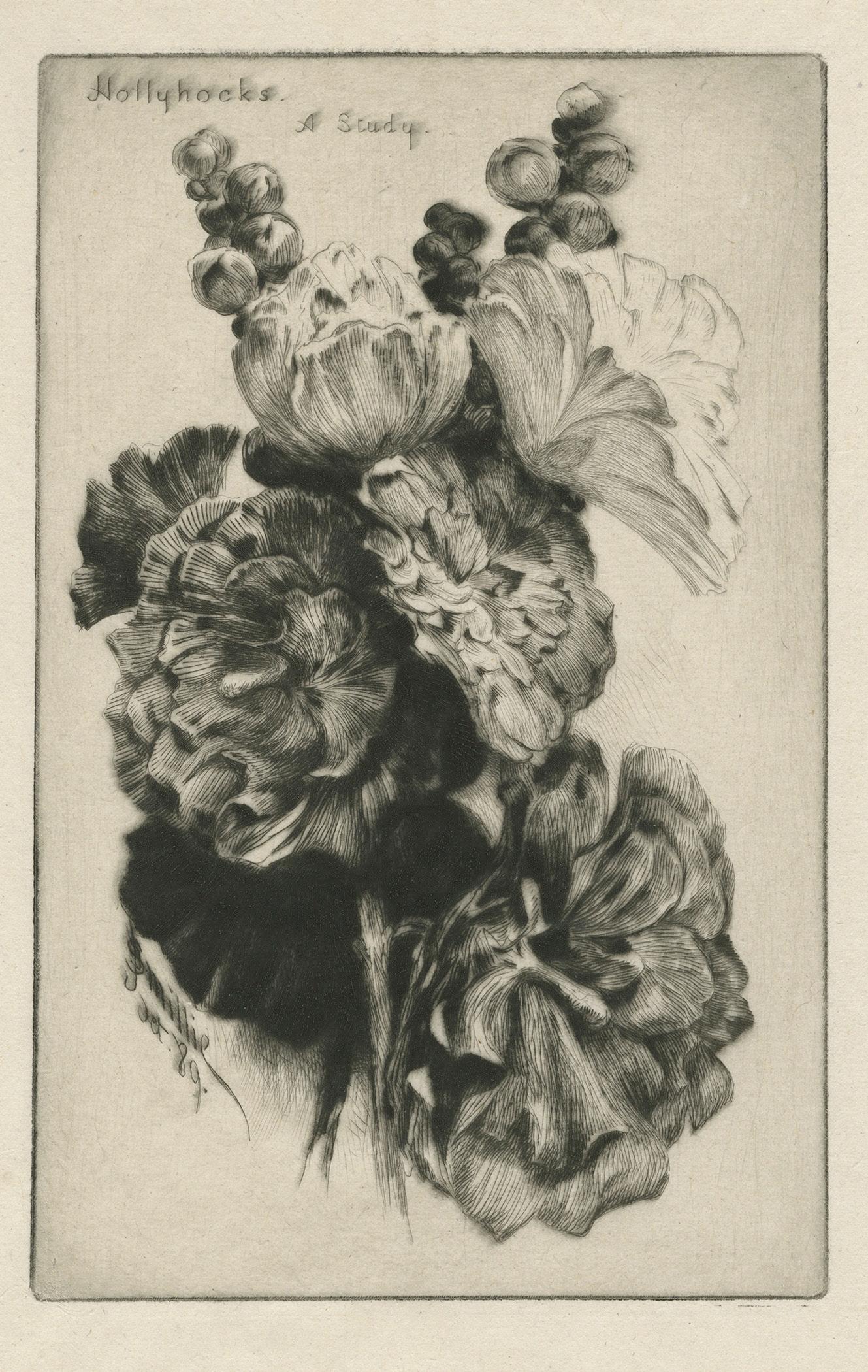
Hollyhocks — A Study
Drypoint; 1889; reference: Witthoff 55, Schantz fig. 5; unsigned proof printed by the artist; incised in the plate in the upper left: “Hollyhocks / A Study”; further incised in the plate in lower left: “J D Smillie / Oct. ‘89”; this impression is illustrated as fig. 5 in Michael W. Schantz’s article “A Joy to the Eye: The Floral Prints of James David Smillie”; on fine, cream laid paper; 6-7/8 x 4-3/8 inches platemark. In 1889, Smillie created a series of floral studies in drypoint, mezzotint, or a combination of both. Inventory: BC220
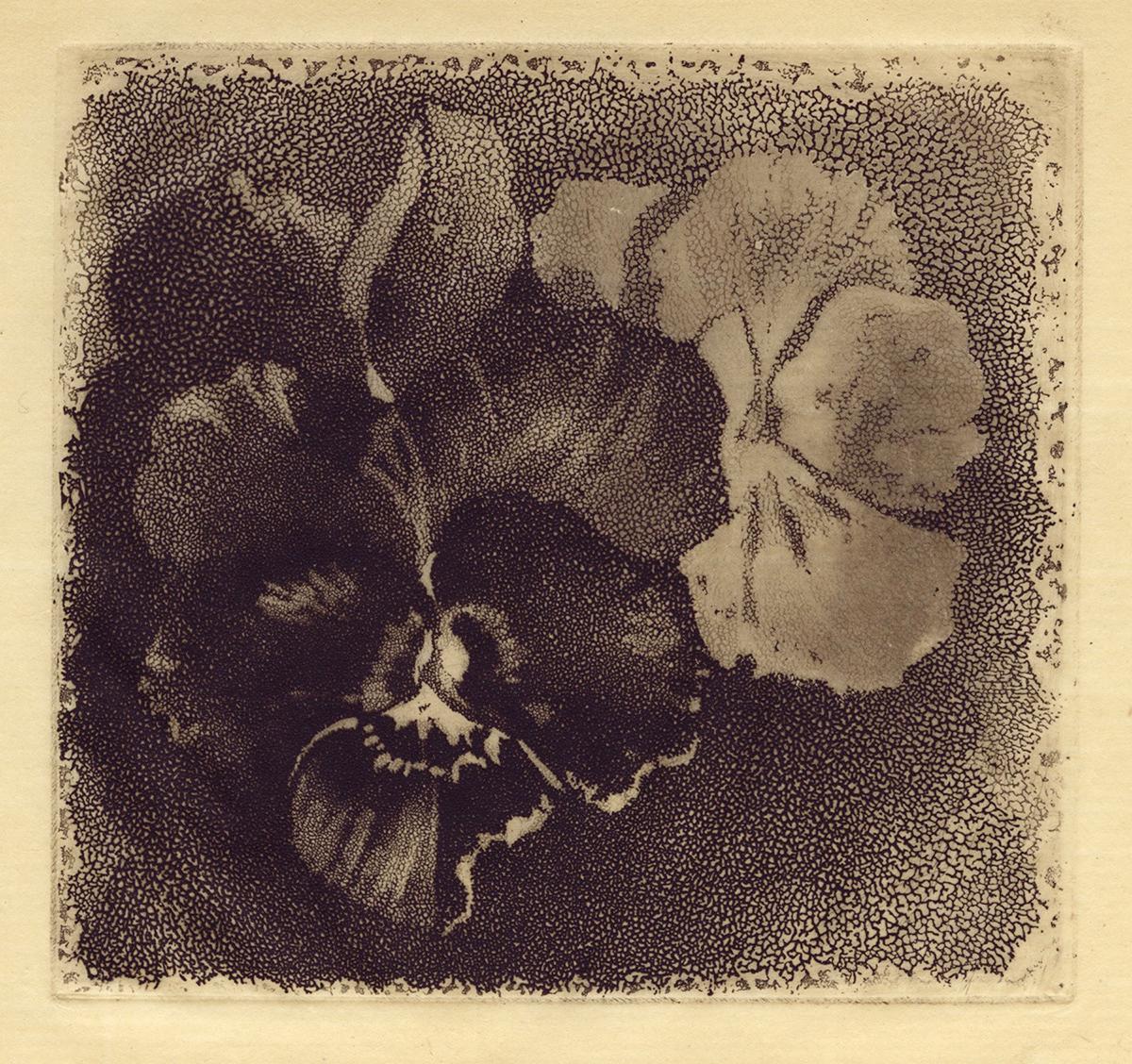
Pansies
Aquatint; 1890; reference: Witthoff 58, Schantz fig. 15; unsigned; posthumously printed by Robert J. Hulse in 1911 and pencil inscribed in the lower left corner of the paper: “Robert J. Hulse imp. March 25th, 1911”; this impression is illustrated as fig. 15 in Michael W. Schantz’s article “A Joy to the Eye: The Floral Prints of James David Smillie”; on fine cream laid paper; 3-1/8 x 3-3/8 inches platemark. According to Witthoff, “Smillie used coarse crackle aquatint, employing wet ground-white resin in alcohol.”
Inventory: BC088
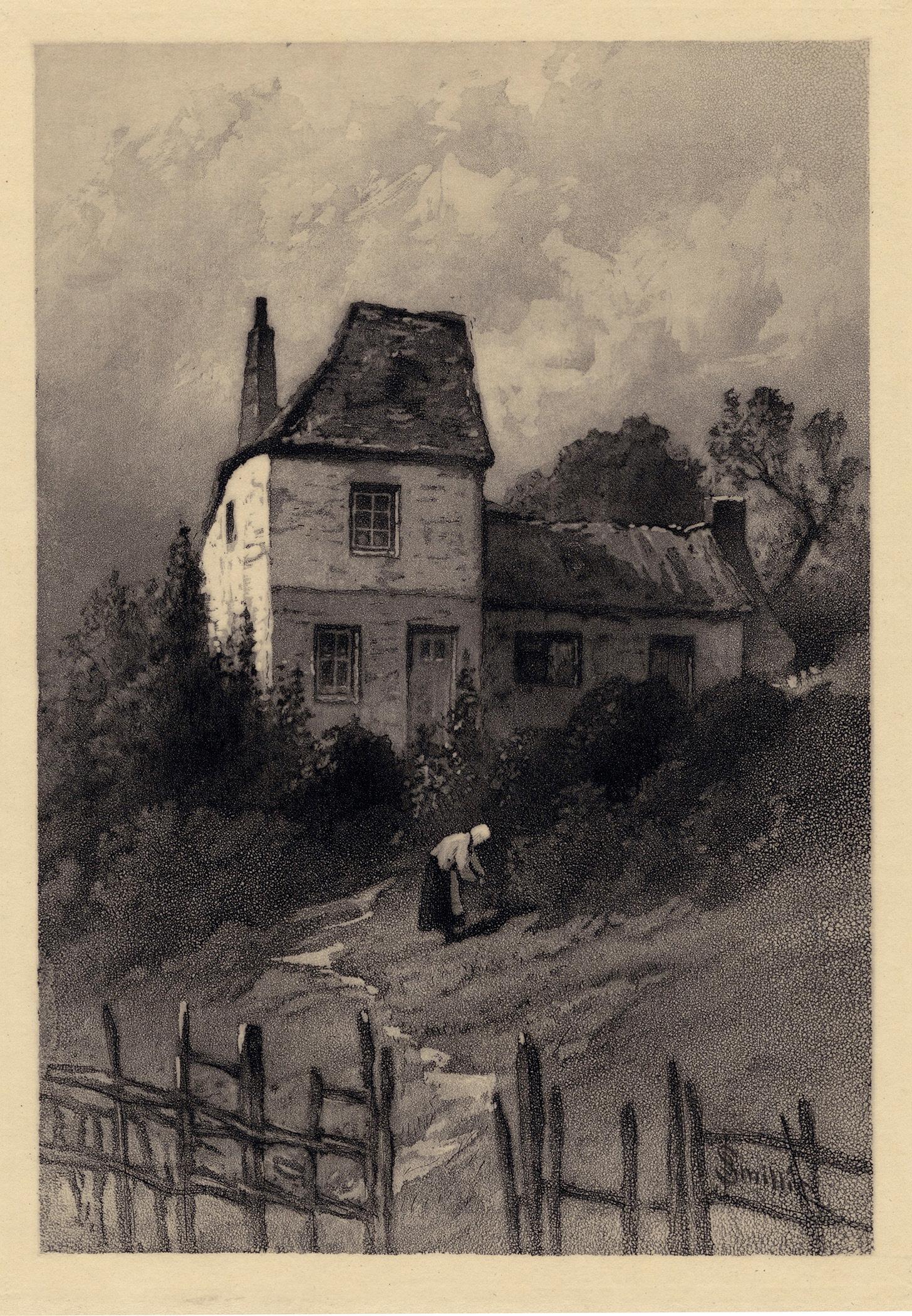
Old House near Boulogne
Aquatint with etching; 1890; reference: Witthoff 60; unsigned; incised in the plate in lower right: “J D Smillie”; Witthoff notes only ten proofs; this is printed on ivory simili vellum paper; 6-7/16 x 4-1/2 inches platemark. The sketch for this aquatint was made from a painting and the plate was an experiment by the artist as he attempted to create lines in aquatint. The etched lines suggest that he wasn’t satisified with his process.
Inventory: BC091
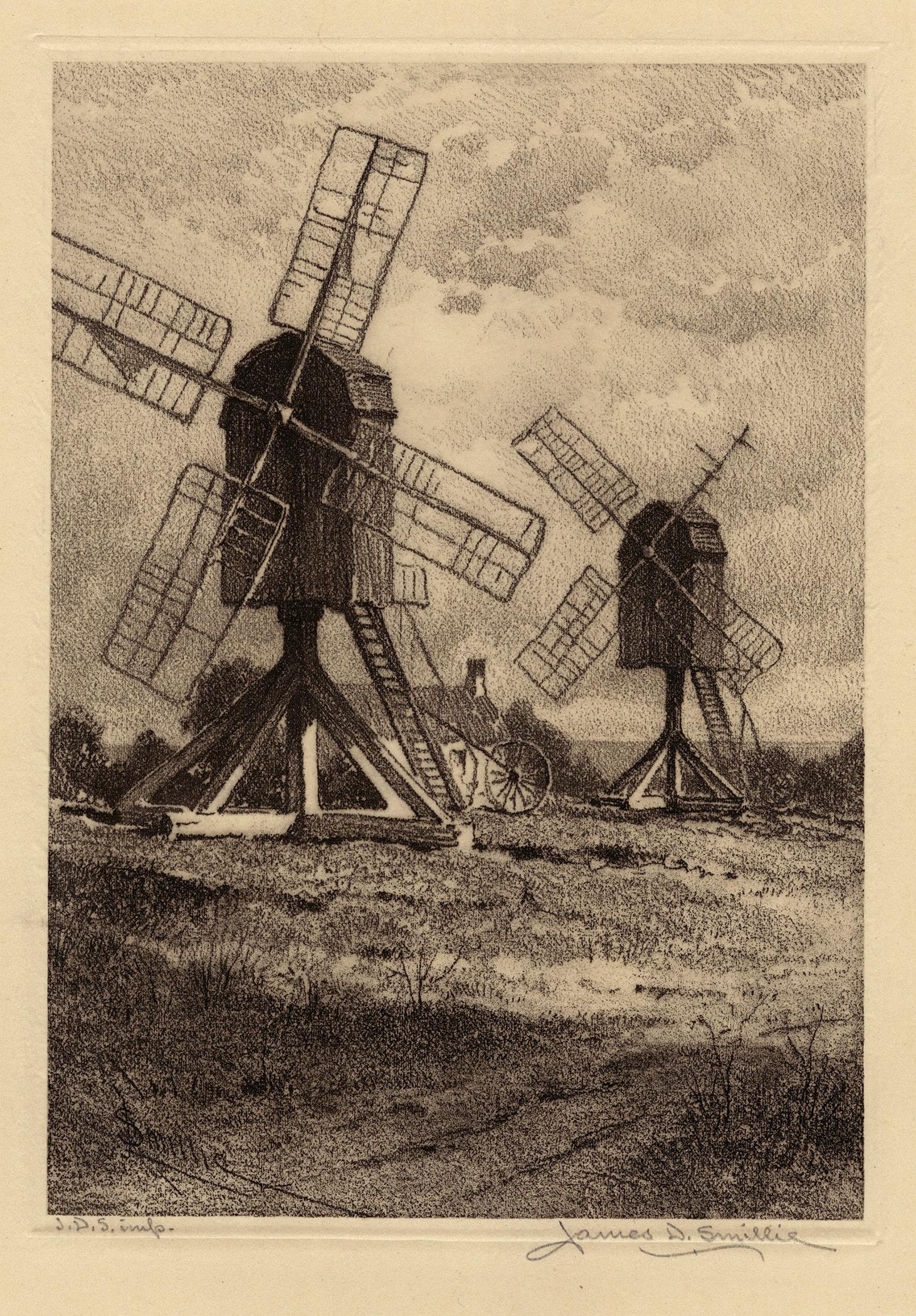
Old Windmills, Virginia
Soft-ground etching; 1890; reference: Witthoff 62; pencil signed and inscribed “J. D. S. Imp.”; the plate is incised with the artist’s name in the lower left corner; printed by the artist on fine, ivory laid paper; 7 x 5 inches platemark. According to Witthoff, Smillie made a sketch of this scene after visiting Virginia Beach. Inventory: BC094
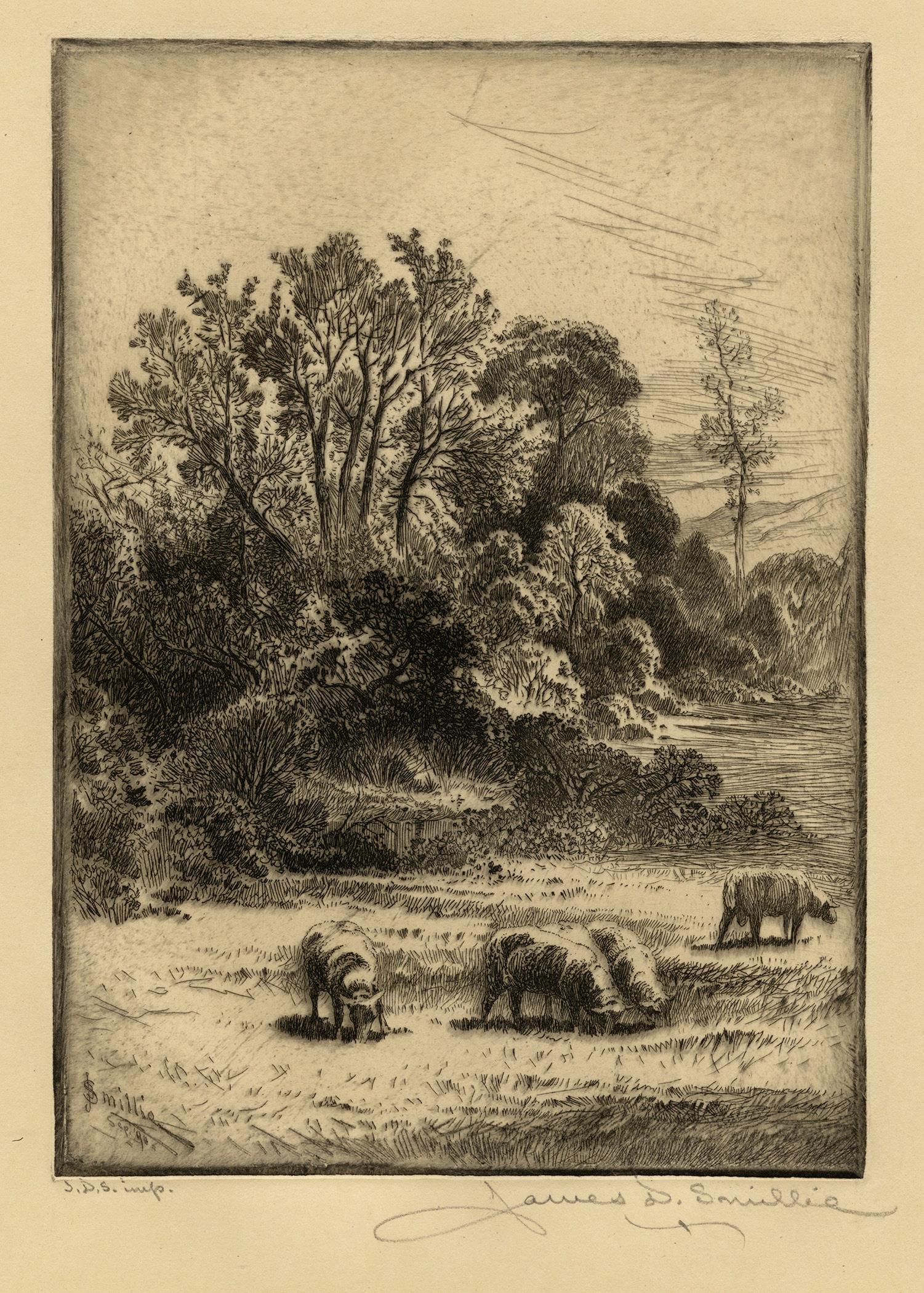
A Bit of Brook with Some Sheep
Etching; 1890; reference: Witthoff 63; state ii/ii; pencil signed and inscribed “J. D. S. Imp.”; incised in the plate in the lower left: “J. D. Smillie / Sep. ‘90”; printed by the artist on a sturdy, cream wove paper; 6-7/8 x 5 inches platemark. According to Witthoff, Smillie was commissioned by the Pratt Institute, Brooklyn, to create a didactic set to demonstrate the technique of free-hand etching. He created a sketch, a tracing of his sketch, a plate that was not bitten, and the plate from which this was printed.
Inventory: BC140
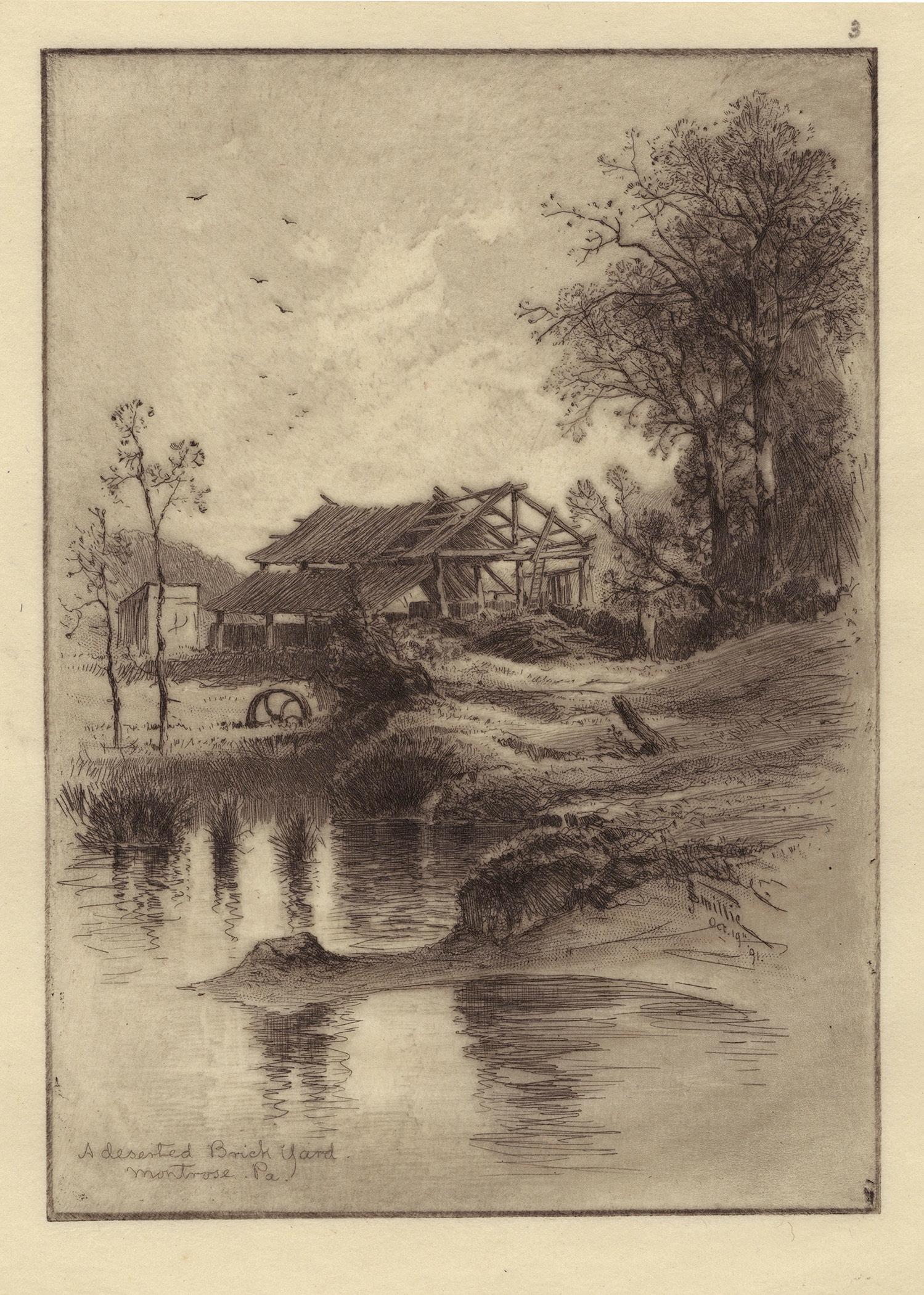
A Deserted Brickyard, Montrose, PA
Etching and aquatint with roulette; 1891; reference: Witthoff 70; unsigned proof; incised in the plate at right: “J. D. Smillie / Oct. 19th, ‘91”; the title is incised in the lower left corner; pencil inscribed “3” above platemark in upper right in unknown hand; printed by the artist on fine, ivory laid paper; 6-7/8 x 4-15/16 inches platemark. According to Witthoff, this was the remains of an old kiln beside a pool of water. It appears that Smillie never printed more than a handfull of proofs.
Inventory: BC208
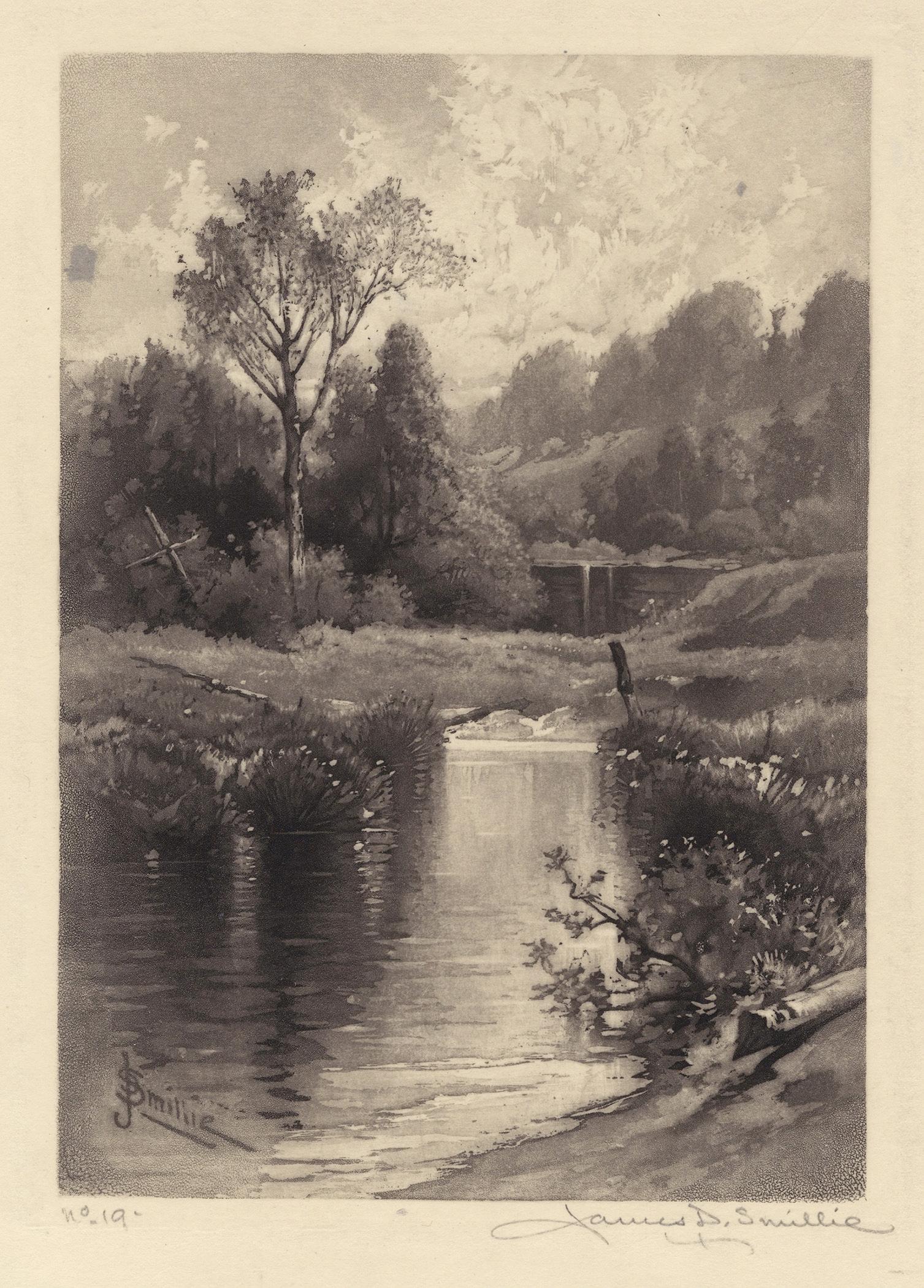
An Old Dam Near Montrose
Aquatint; 1891; reference: Witthoff 71; state ii/ii; pencil signed and inscribed “No. 19-”; the artist’s name is incised in the plate in the lower left; printed by the artist on ivory Imperial China paper; commissioned by the Pratt Institute, Brooklyn; 7 x 5-1/8 inches platemark; reproduced in Weitenkamp’s American Graphic Art, 1912, facing page 105. Witthoff states that Smillie didn’t record two states but he exhibited both at the New York Etching Club in 1892.
Inventory: 22085
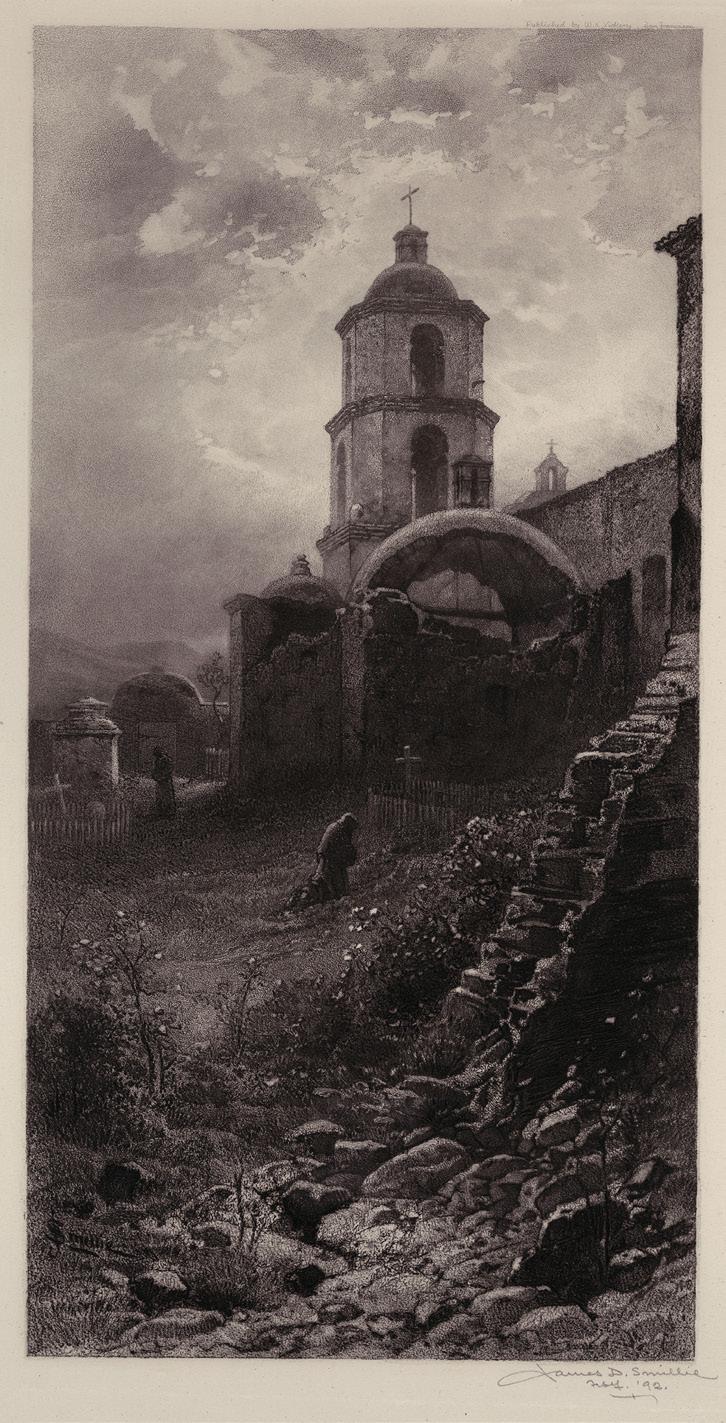
San Luis Rey Mission, Cal.
Etching, soft-ground etching and aquatint, printed chine-collé; 1892; reference: Witthoff 73; state ii/ii; pencil signed and dated “Feb. 7 ‘92”; one of the first few proofs before publication by W. K. Vickery, San Francisco; incised in the plate with the name of the artist; 15-3/4 x 8 inches image; the platemark extends well beyond the china paper which is supported on sturdy, cream wove paper. According to Witthoff, Smillie painted the mission from a photograph and then reduced the painting via photography to make this etching. Inventory: BC191
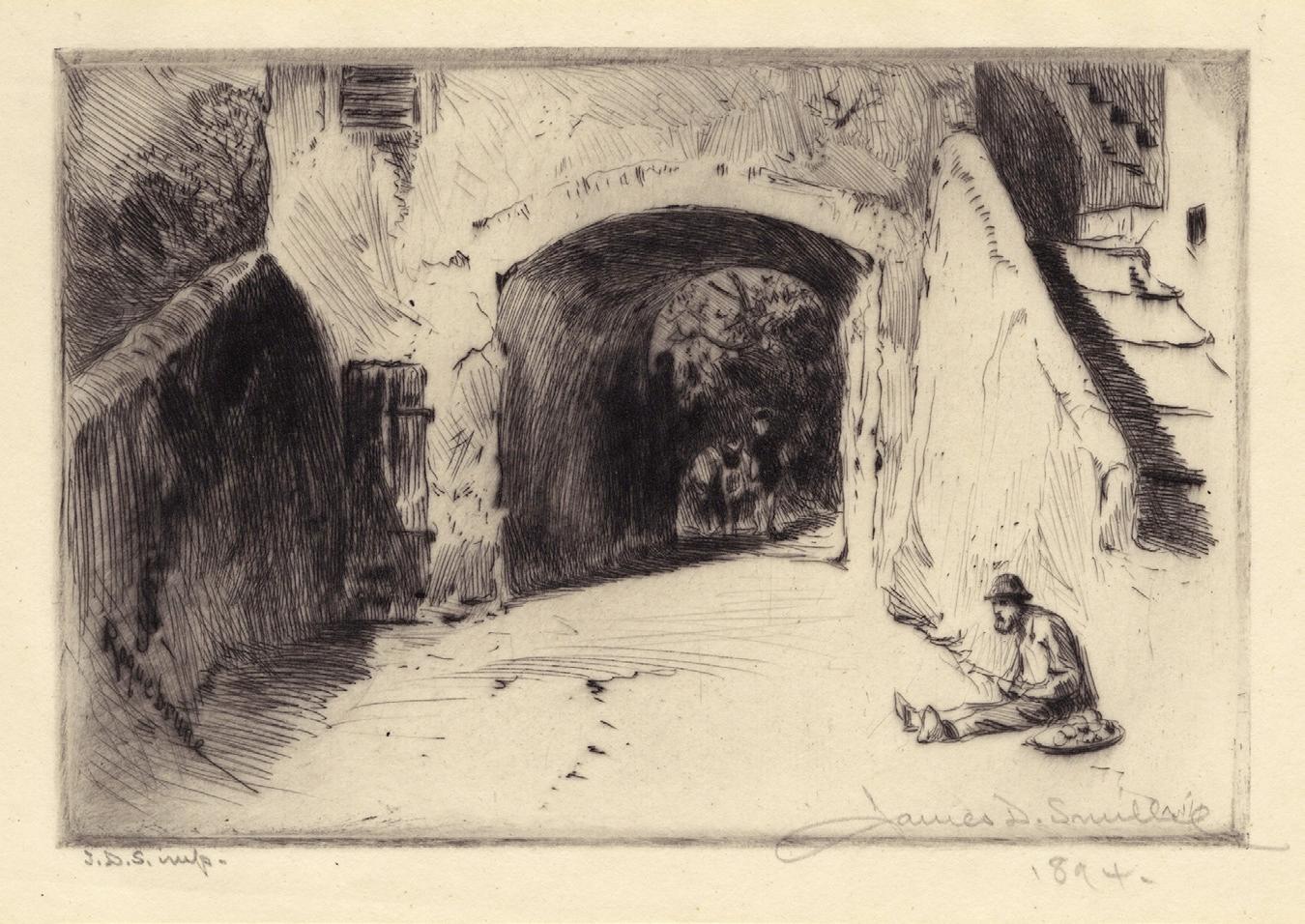
A Gateway, Roquebrune a.k.a. Roquebrune
Drypoint on a celluloid plate; 1894; reference: Witthoff 74; pencil signed within image in lower right; also inscribed “J. D. S. imp.” and dated “1894” beneath the image and “Drypoint - Celluloid plate- / London” in lower margin; incised in the plate in lower left: “Roquebrune”; printed by the artist on fine cream wove paper; 3-15/16 x 5-7/8 inches platemark. According to Witthoff, Smillie was discouraged with his experiment with celluloid after two attempts with the medium.
Inventory: BC187
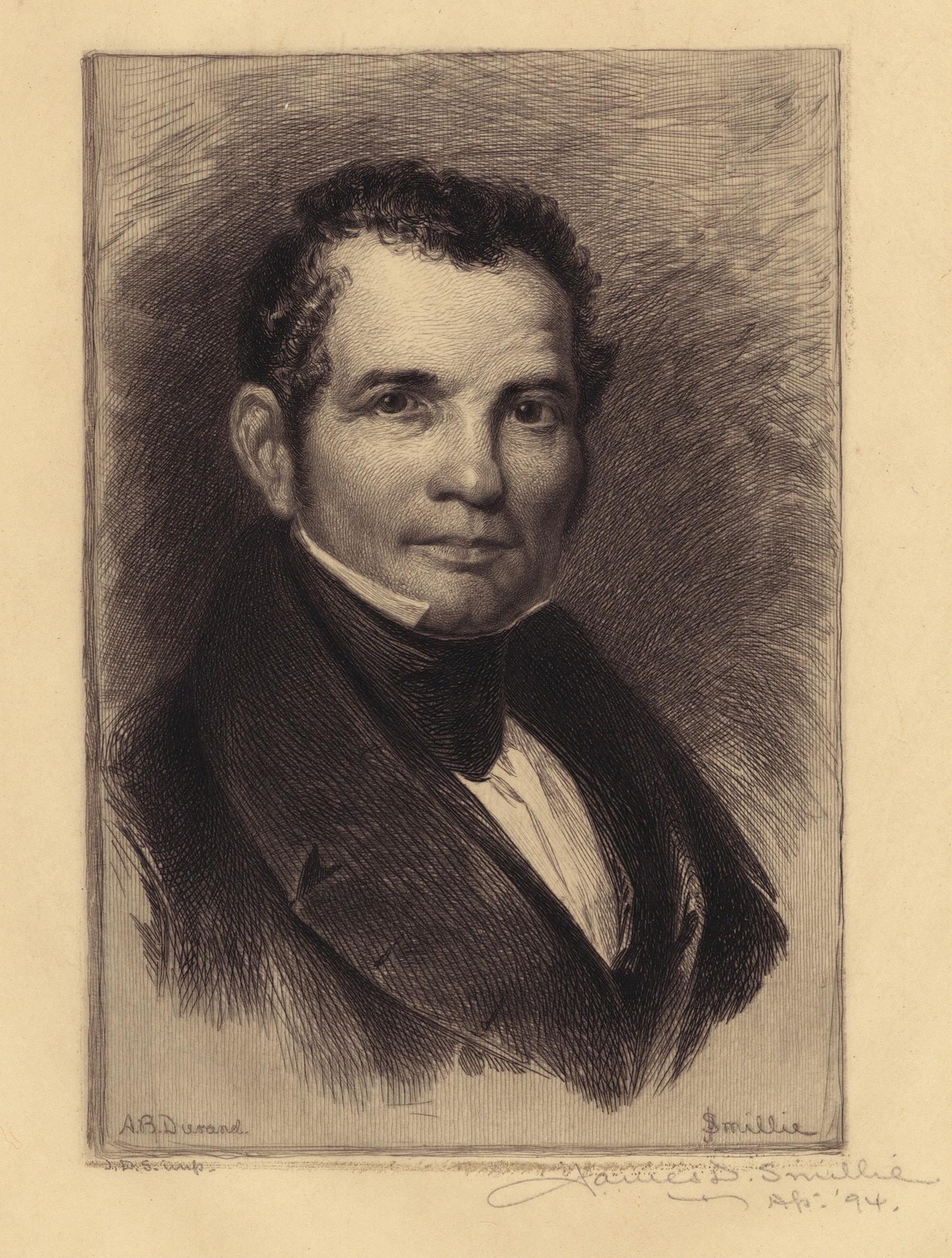
Portrait of Luman Reed, after Asher B. Durand
Etching; 1894; reference: Witthoff 79; state i/ii; pencil signed and dated “Ap. ‘94” in lower right and inscribed “J. D. S. imp.” in lower left; incised in the plate “A. B. Durand” and “J. D. Smillie”; printed by the artist on fine, cream wove paper; 5-13/16 x 4 inches image, 10 x 6-7/8 inches platemark. This portrait was etched for John Durand, Life and Times of A. B. Durand, but not used. Luman Reed was an early collector of American painting and a patron of Durand. Inventory: 4045
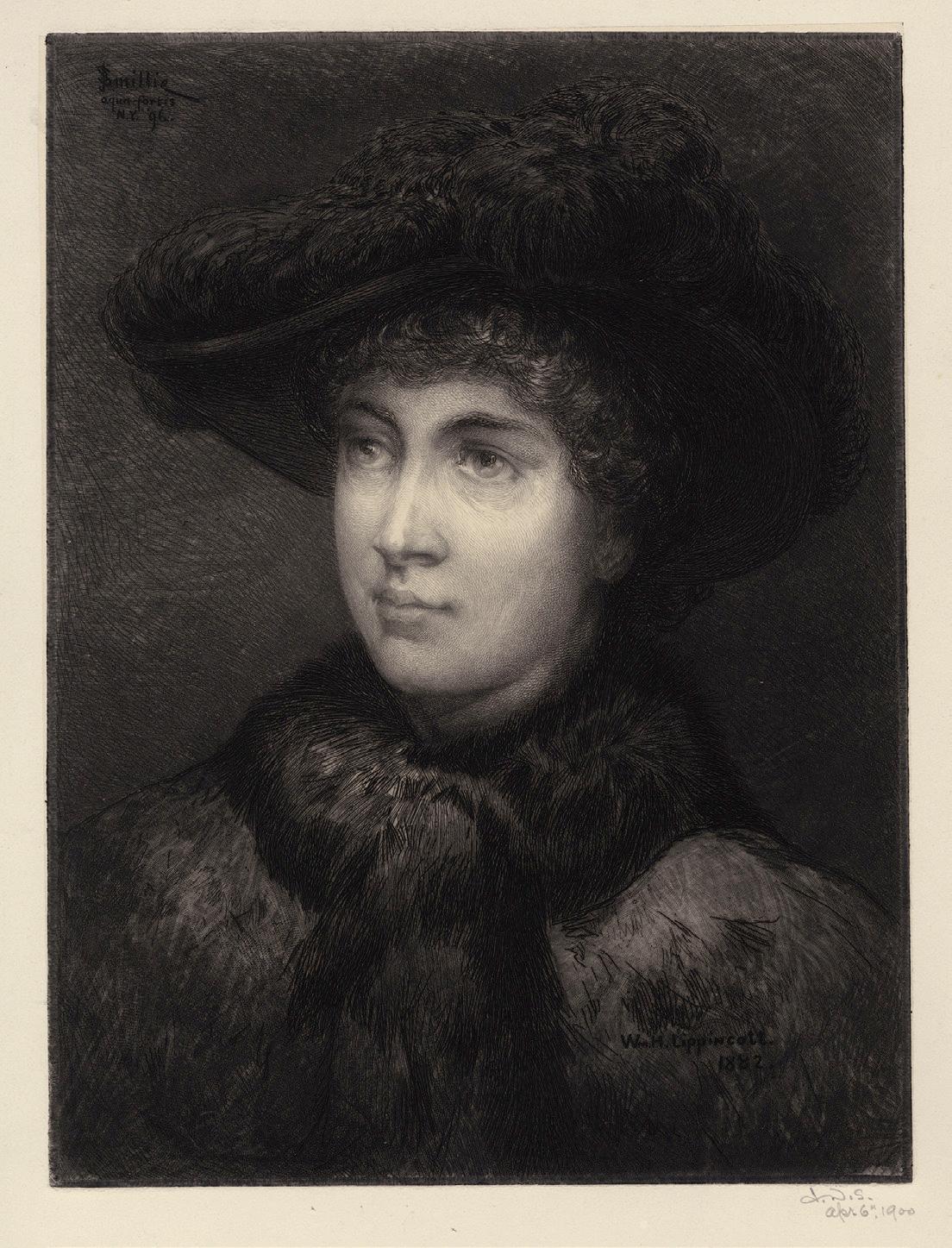
Girl’s Head with Plumed Hat, after William H. Lippincott
Etching with roulette; 1896; reference: Witthoff 85; state ii/iii; pencil signed and dated in lower right: “J. D. S. / Apr 6th, 1900”; incised in the plate in the upper left: “J. D. Smillie / aqua fortis / N. Y. ‘96” and in the lower right: “Wm. H. Lippincott / 1882”; proof printed by the artist on sturdy, ivory wove paper; 11-15/16 x 8-15/16 inches platemark. According to Witthoff, Smillie began the plate in 1891, worked on it again in 1896, 1900, and 1901. It was based upon a watercolor by Lippincott. Inventory: BC059
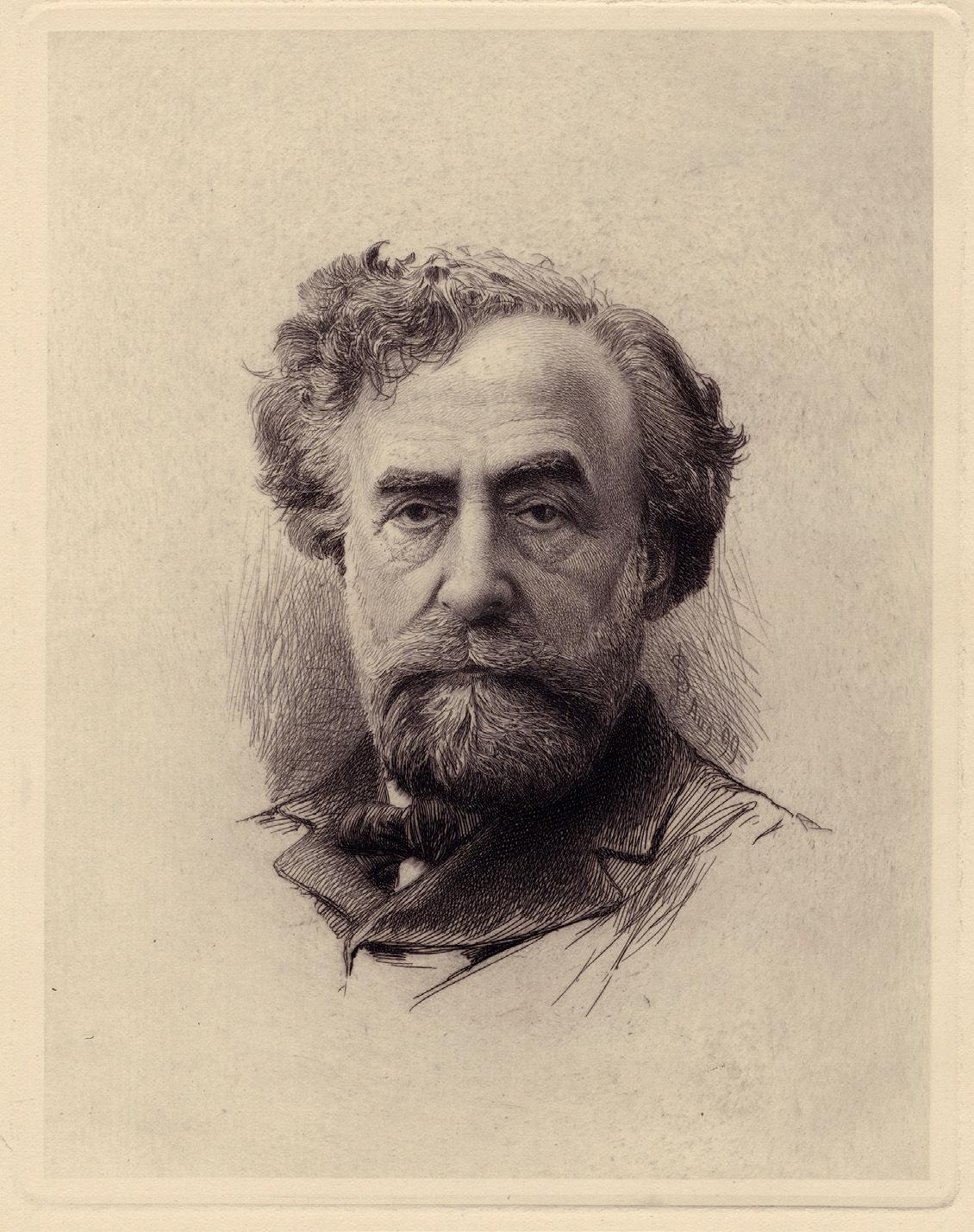
Portrait of Dr. Abraham Jacobi
Etching and drypoint; 1899; reference: Witthoff 89; state i/ii; unsigned proof; plate is incised within image in center right “J. D. S. Aug. ‘99”; printed by the artist on a heavy, cream wove paper; 8-7/8 x 7 inches platemark. Abraham Jacobi was Professor of Pediatrics at the College of Physicians and Surgeons in New York and was known for his fostering of medical research. This portrait was commissioned by his friend, Dr. Arpad G. Gerster. Inventory: BC172
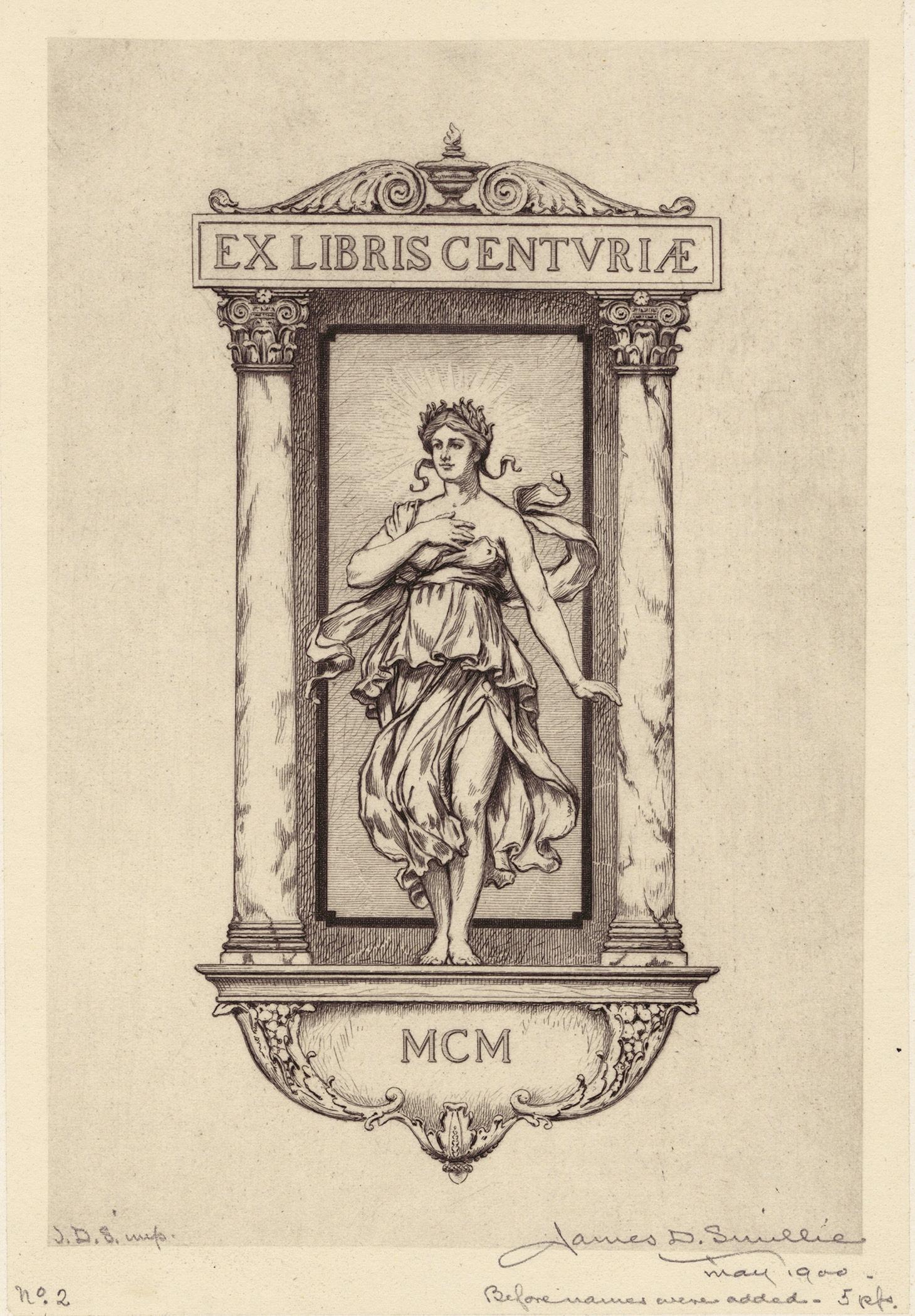
Ex Libris — Century Association, after George W. Maynard
Etching printed chine collé; 1900; reference: Witthoff 92; state i/ii; pencil signed in lower right; further inscribed by Smillie: “J. D. S. imp. / May 1900 / Before names were added. 5 pfs. / No. 2”; trial proof; printed by Smillie on China paper which is supported on sturdy, cream wove paper; 6-3/8 x 4-3/8 inches platemark. Inventory: BC107
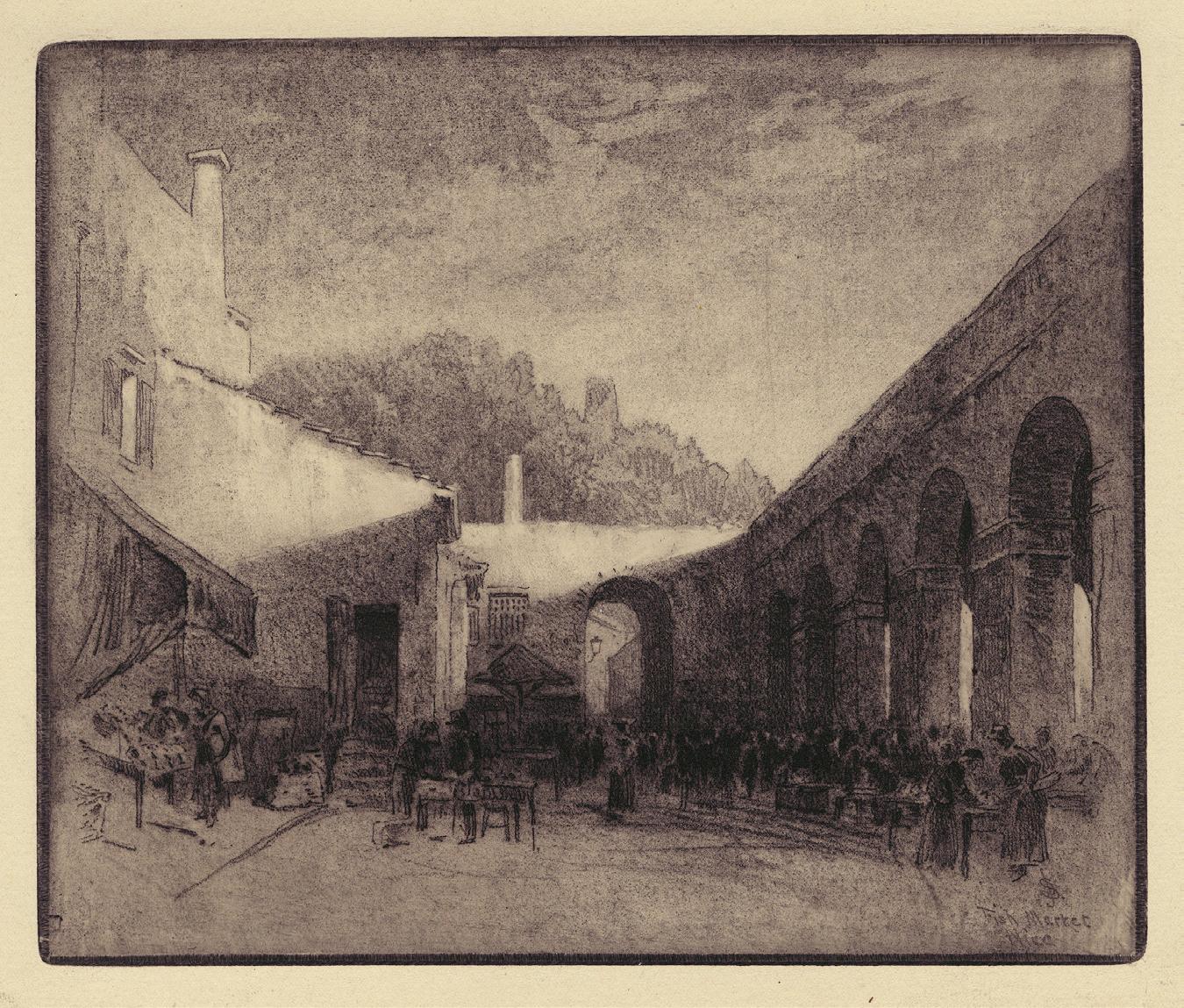
Fish Market, Nice
Soft-ground etching; 1901; reference: Witthoff 97; unsigned proof; incised in the plate in the lower right image: “J. D. S. / Fish Market / Nice”; pencil incribed “museum” in lower right corner of the paper; printed by the artist on cream wove paper; 7-1/2 x 8-15/16 inches platemark. Smillie inscribed the proof in the New York Public Library “an example for my etching class at NAD.” Witthoff notes that the drawing for the etching was created in Nice on 8 February 1893. Inventory: BC189
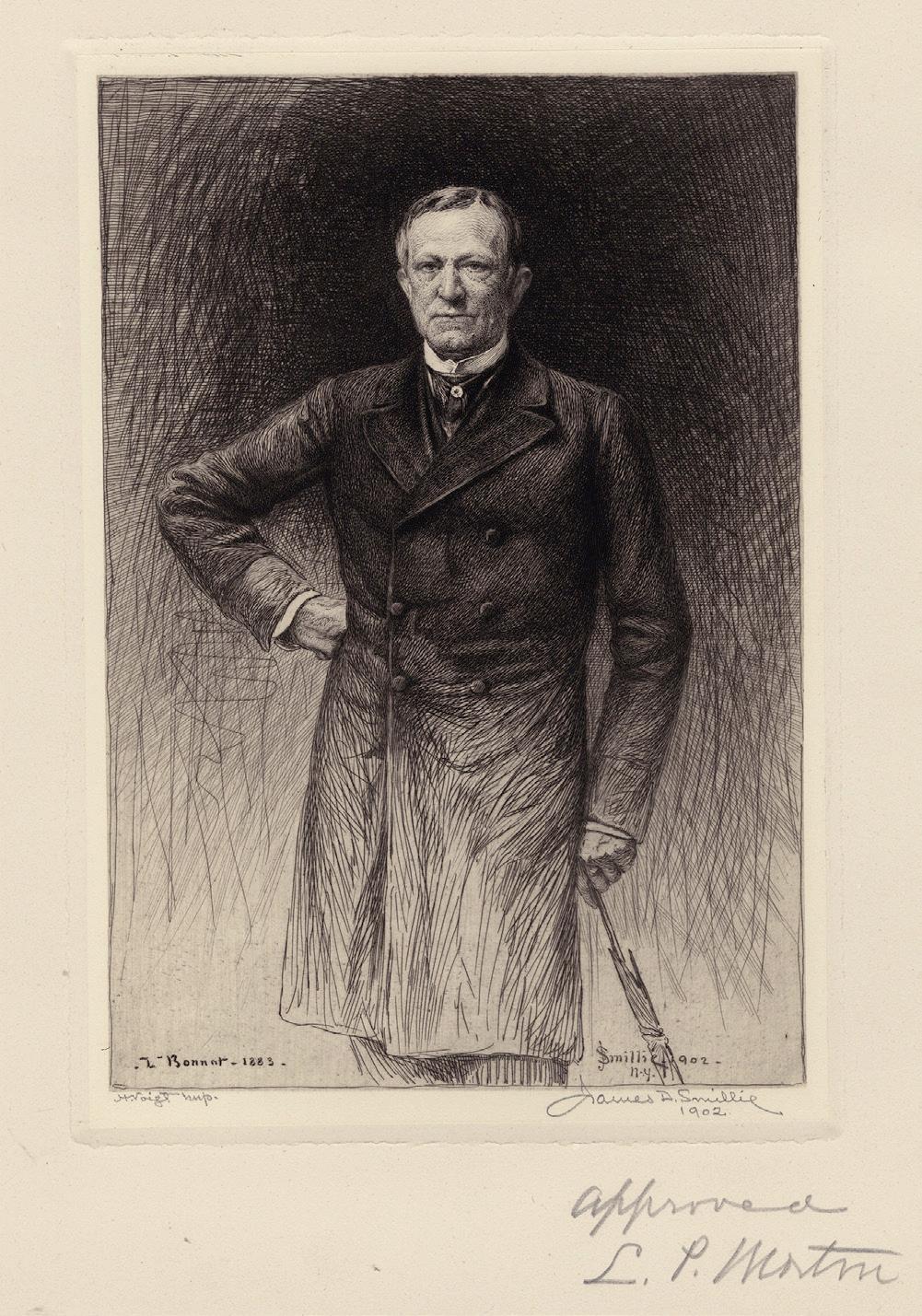
Portrait of Hon. Levi P. Morton, after Léon Bonnat
Etching printed chine collé; 1902; reference: Witthoff 98; pencil signed and dated beneath the image; also inscribed in lower left: “H.Voight Imp.”; incised in the plate in the lower left: “L. Bonnat -1883” and incised in the lower right: “J.D. Smillie 1902 - / N.Y.”; pencil signed by the subject in the lower right margin: “approved / L. P. Morton”; printed by Hy Voight; 8-1/2 x 5-15/16 inches platemark. Morton headed a N.Y. banking firm before becoming the vice president of the United States and then governor of New York. Inventory: 4052
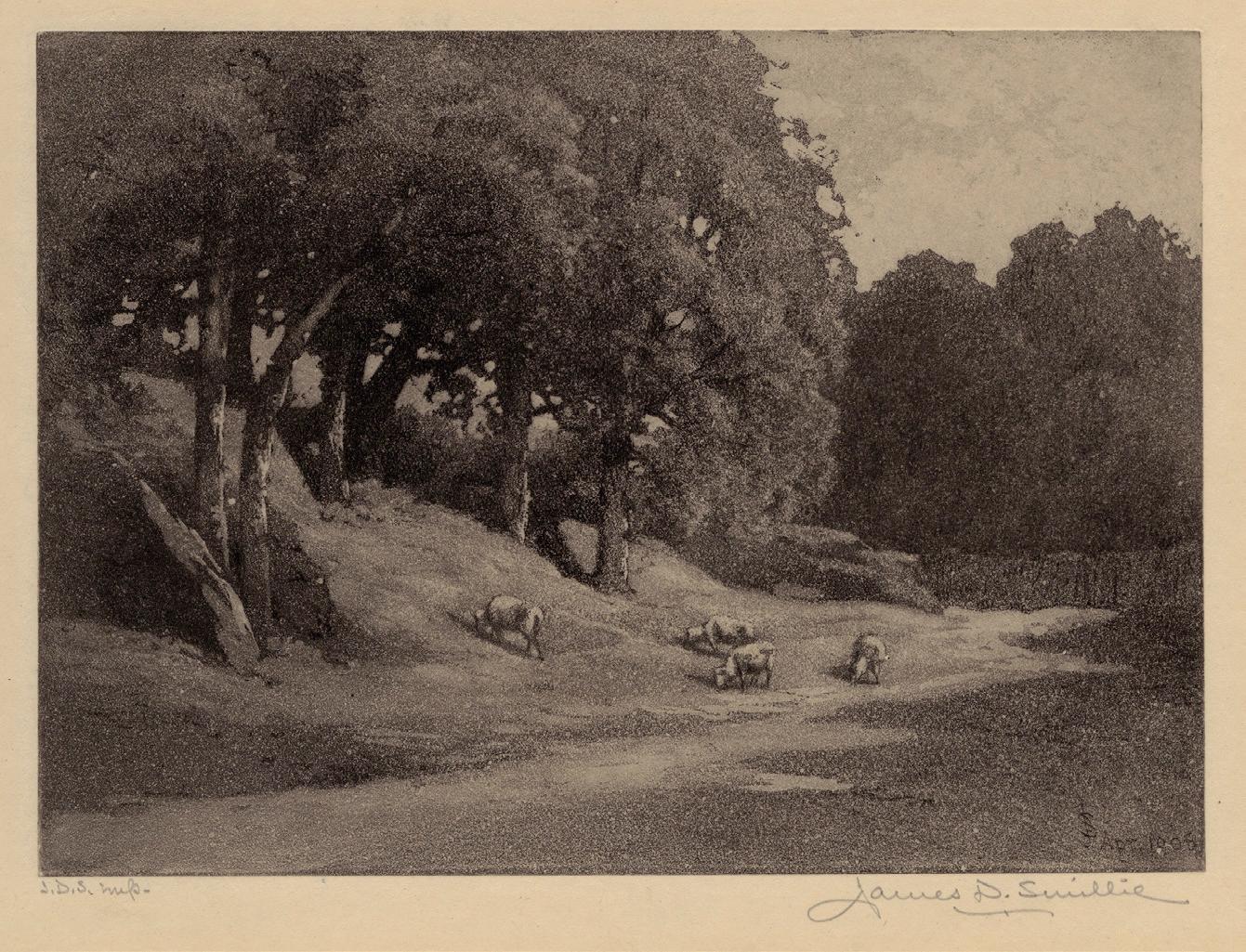
Fairground, Montrose, with Sheep
Soft-ground etching and aquatint; 1905; reference: Witthoff 105; state ii/iii before mezzotint and drypoint added; pencil signed in lower right and pencil inscribed in lower left: “J. D. S. Imp.”; incised in the plate in the lower right: “J. D. S. Apr. 1905”; printed by the artist on a sturdy, cream wove paper; 5 x 6-15/16 inches platemark. According to Witthoff, the scene is the old fairgrounds at Montrose, Pennsylvania. Smillie painted this landscape many times between 1887 and 1892.
Inventory: BC170
James David Smillie was born in New York City on January 16, 1833. He studied at the Poughkeepsie Collegiate School and later at the University of New York. He learned engraving from his father, James Smillie, and, in January 1846, tried his first attempt at composition in watercolor. Smillie was employed as a bank note engraver before he and his father started their own engraving business. After a four-month tour of Europe in 1862, James D. turned to landscape painting. His younger brother George, also an artist, had a studio in New York City and James D. rented a room in the same building. James D. sought inspiration for his imagery in the Catskills and the Hudson Valley, eastern Pennsylvania, and western Massachusetts.
In 1864, James D. Smillie exhibited in the spring exhibition of the National Academy of Design and at the Brooklyn Art Association. He was elected an associate of the National Academy of Design in 1865 and taught at the Academy in 1868. In 1866, he co-founded the American Society of Painters in Water Colors. He was elevated to full Academician in the National Academy of Design in 1876.
The Smillie brothers received a financial gift from an uncle which allowed them to live for four months in Yosemite in 1871. During that summer, James drew, painted, and wrote about the majestic splendor of the Yosemite valley. In 1872, Picturesque America was published by D. Appleton and Company of New York. James wrote “The Yosemite” section based upon his journal entries and illustrated it with engravings after his drawings and paintings.
James D. Smillie headed the watercolor committee for the Centennial International Exhibition of 1876. In 1877, he co-founded the New York Etching Club and he was elected an “original fellow” of the London Society of Painter-Etchers in 1881. In 1894, he conducted the first etching class at the National Academy of Design and continued to teach there until 1903.
Smillie’s last years were spent working as a consultant to Frank Weitenkampf, head of the New York Public Library Art Department. James D. donated his father’s engravings and his own etchings to the library’s collection. His works are also represented in the collection of the Library of Congress.
James David Smillie died on 14 September 1909 in New York City.
